NEET Biology Notes Animal Kingdom Introduction
The animal kingdom covers about 35 phyla, of which 11 are considered to be major phyla. In major phyla, 10 are from non-chordates and one is from chordates.
NEET Biology Notes Animal Kingdom Terminologies Related To Animal Classification
Metazoa
- Animal groups are characterized by mobility and the presence of a sensory or a nervous system. These systems receive stimuli from the environment and animals respond by exhibiting some behavior.
- The only exceptions is of poriferans (pore-bearers) or the sponges. They have no cells that can be termed as nerve cells.
- Like plant life, early animal life also arose in the sea. The animals that live on the sea floor are called benthonic (for example, echinoderms, corals, and deep sea fishes), whereas those that swim about actively in the sea are called nektons.
- The multicellular eukaryotic organisms with the holozoic mode of nutrition are called metazoans. Based on the complexity of the organization, metazoans are further subdivided into two sub-kingdoms, Parazoa and Eumetazoa.
Parazoa: Parazoa include the sponges in which cells are loosely aggregated and do not form tissues or organs.
Eumetazoa: Eumetazoa includes the rest of animals in which cells are organized into structural and functional units called tissues, organs, and organ systems.
Levels Of Organization
- Cellular Level
- Though all members of Animalia are multicellular, all of them do not exhibit the same pattern of cell organization. For example, in sponges, the cells are arranged as loose cell aggregates, i.e., they exhibit a cellular level of organization.
- Some division of labor (activities) occurs among the cells.
- Tissue Level
- In coelenterates and ctenophores, the arrangement of cells is more complex.
- Here, the cells performing the same function are arranged into tissues. Hence, it is called the tissue level of organization.
- Organ Level
- A still higher level of organization, i.e., organ level is exhibited by the members of Platyhclminthes and other higher phyla where tissues are grouped together to form organs, each specialized for a particular function.
- In animals such as annelids, arthropods, mollusks, echinoderms, and chordates, organs are associated to form functional systems, each system concerned with a specific physiological function. This pattern is called the organ system level of the organization. Organ systems in different groups of animals exhibit various patterns of complexities.
- For example, the digestive system in Platyhclminthes has only a single opening to the outside of the body that serves as both mouth and anus and is hence called incomplete.
- A complete digestive system has two openings, mouth and anus.
Read and Learn More NEET Biology Notes
Similarly, The Circulatory System May Be Of Two Types: Open Type And Closed Type.
Open Type
- In this type of circulatory system, the blood is pumped out of the heart and the cells and tissues are directly bathed in it. The blood is pumped by the heart into the blood vessels that open into blood spaces (sinuses).
- There is no capillary system (for example, in most arthropods, non-cephalopod mollusks and tunicates). These sinuses are actually the body cavities and are called hemocoel.
- The pressure of the blood is low; it moves slowly between the tissues and, finally, returns to the heart via open-ended blood vessels.
” animal kingdom table”
Closed Type
- Many invertebrates and all vertebrates, including humans, have a closed circulatory system. In the closed type, the blood flows inside the body through a series of blood vessels of varying diameters (arteries, veins, and capillaries).
- In this system, the same blood regularly circulates in the body under high pressure and returns back to the heart without leaving the system of tubes.
Symmetry: Based on the basis of their body symmetry, animals can be categorized as follows:
- Radial Symmetry: When any plane passing through the central axis of the body divides the organism into two identical halves, it is called radial symmetry. The animals with radial symmetry are put in the group Radiata, for example, cnidarians (hydra and jellyfish). Biradial symmetry is present in sea anemones, and ctenophores.
- Bilateral Symmetry: The animals with bilateral symmetry arc put in the group Bilateria. The body can be divided into identical right and left halves in only one plane. For example, platyhclminthcs, annelids, arthropods, etc. (platyhel-minthes to chordates).
- Asymmetry: Asymmetric organisms cannot be divided along any plane to produce two equivalent halves. Sponges are mostly asymmetrical.
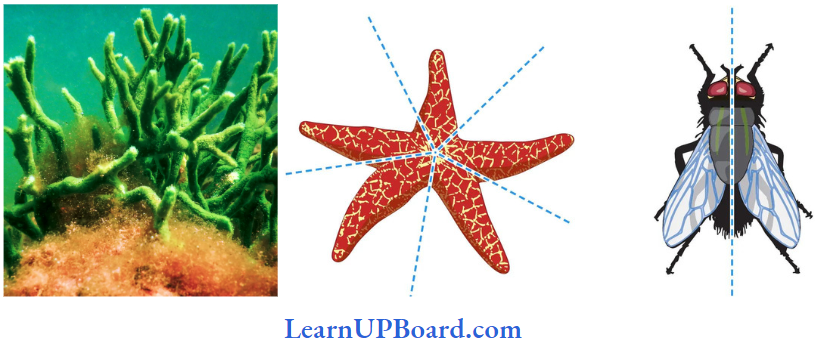
Germ Layers: Germ lavers give rise to all the tissues and organs of a fully formed individual. On the basis of the number of germ layers, animals can be diploblastic or triploblastic.
- Diploblastic: In diploblastic animals, the body cells are arranged in two layers an outer ectoderm and an inner endoderm with an intervening undifferentiated mesoglea, for example. coelenterates.
- Triploblastic: The body wall in animals is made of three germ layers, i.e…. ectoderm, mesoderm, and endoderm, for example, platyhel-minthes to chordates.

Body Plan: Though diverse in shape and size, animals have a body that fits in one of the three basic plans:
- Cell Aggregate: Cell aggregate type of body plan is present in sponges. They are clusters of cells with a rudimentary division of labor among them. There are no tissues or organs.
- Blind Sac: A blind sac type of body plan is present in Platyhelminthes and Coelenterata where the alimentary canal has only one opening.
- Tube Within Tube: Tube-within-tube type of body plan is present in N’emathelminthes, Annelida, Arthropoda, Mollusca, Echinodermata, and Chordata. The digestive system is a continuous tube with an opening at both ends.
Body Cavity Or Coelom: The presence or absence of a cavity between the body wall and gut wall is very important for classification.
- Eucoelomates: True coelom is a body cavity that arises as a cavity in embryonic mesoderm. In this case, the mesoderm of the embryo provides a cellular lining, called coelomic epithelium or peritoneum, to the cavity. The coelom is filled with coelomic fluid secreted by the peritoneum. True coelom is found in annelids, echinoderms, and chordates. The true coelom is of two types:
- Schizococlom: It develops by the splitting up of mesoderm. It is found in annelids, arthropods, and mollusks. The body cavity of arthropods and non-cephalopod mollusks is called hemocoel.
- Enterocoelom: The mesoderm arises from the wall of the embryonic gout or enteron as hollow outgrowths or enterococlomic pouches. It occurs in echinoderms and chordates.
- Pseudocoelomntcs: The body cavity is not completely lined with mesoderm. Instead, the mesoderm is present as scattered pouches in between the ectoderm and endoderm. Such a body cavity is called a pseudocolor, for example, in roundworms.
- Acoelomates: The animals in which the coelom is absent are called acoelomates, for example, poriferans, coelenterates, ctenophores, and flatworms. In flatworms, the spaces between various organs are filled with a special tissue called parenchyma.
” ctenoplana diagram”

Segmentation
- In some animals, the body is externally and internally divided into segments with a serial repetition of at least some organs.
- For example, in earthworms, the body shows a pattern called metameric segmentation, and the phenomenon is known as metamerism.
- Metameric segmentation is present in annelids only.
Notochord: Notochord is a mesodermally derived rod-like structure formed on the dorsal side during embryonic development in some animals. Animals with notochord are called chordates and animals which do not have this structure are called non-chordates, for example, porifera to echinoderms.
NEET Biology Notes Animal Kingdom Phylum Protozoa (Unicellular Protists)
There are about 15,000 species of protozoans known to exist in the world. They are microscopic heterotrophic organisms in which a single cell performs all the vital activities. For this reason, protozoans are also referred to as acellular organisms.
They are aquatic (freshwater and marine) and cosmopolitan in distribution. Some forms are predators and some are parasitic. The protozoan cell body is either naked, for example, Amoeba, or surrounded by a non-rigid pellicle. Cellulose is absent in the pellicle.
- Some protozoans secrete shells of various inorganic compounds as external covers (foraminiferans).
- Different types of locomotory structures are found in protozoans. They may bear flagella (flagellates), cilia (ciliates), or pseudopodia (sarcodines).
- Locomotory structures are absent in the parasitic forms (sporozoa).
- In protozoans, neurofibrils and contractile myofibrils are present underneath the cell surface. Most protozoans are free-living and aquatic.
- They are holozoic and feed largely on bacteria, microscopic algae, and minute animals such as rotifers or on other protozoans including members of their own species.
- Some protozoans are holophytic; they contain chlorophyll and prepare their own food by photosynthesis (for example, Euglena, Amoeba, Paramecium, Elphidium). The parasitic protozoans feed on materials obtained from the hosts (for example, Monocystis, Entamoeba, Plasmodium, Trypanosoma, Giardia, etc.).
The contractile vacuole is found in almost all freshwater protozoans for the maintenance of the osmotic concentration of the cell body. This phenomenon is known as osmoregulation. The contractile vacuole also helps in excretion.
- Many sporozoan parasites are relatively harmless but some are harmful also. For instance, Plasmodium vivax and Plasmodium falciparum cause malaria in humans. Protozoans are generally uninucleate, but all ciliates and many amoeboid types are multinucleate.
- The pattern of reproduction is also specialized in different protozoans. Most sarcodines, flagellates, and ciliates show asexual reproduction by binary fission, multiple fission, or even budding.
- Some ciliates, for example, Paramecium reproduce by sexual means in which two individuals come close to each other and interchange genetic information by a process known as conjugation.
- There is no gamete formation in such a process. In sporozoa, some stages of the life cycle show the formation of gametes, which are morphologically distinct.
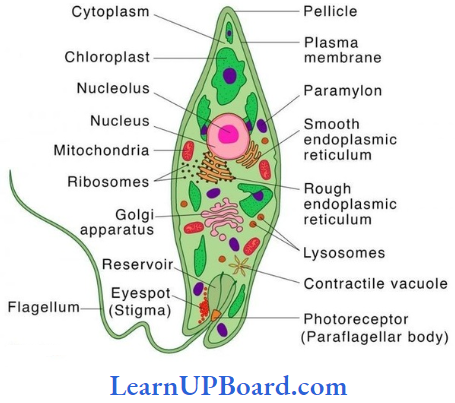
Classification Of Phylum Protozoa: Phylum protozoa is divided into four groups: Rhizopoda or Sar- codina, Mastigophora or Flagellata, Sporozoa, and Ciliata.
Group 1 Rhizopoda Or Sarcodina: The locomotion is by pseudopodia; body shape changeable, for example, Amoeba (free-living), Entamoeba (parasitic or commensal), etc. Four types of pseudopodia are: lobopodia {Amoeba), filopodia (Euglypha), reticulopodia (Globigerina), and axopodia (Actinopluys sol).
Group 2 Mastigophora Or Flagellata: The locomotion by one or more thread-like flagella. They are free-living or parasitic. For example,
- Euglena: Connecting link between plants and animals
- Trypanosoma: Parasite causing sleeping sickness
- Leishmania: Parasite causing kala-azar
- Giardia: Parasite causing diarrhea
- Trichomonas: Parasite causing vaginitis in human females
- Trichonympha: Symbiont found in the gut of termite helping in cellulose digestion
- Proterospongia: Colonial with collar cells, a connecting link between Protozoa and Porifera
Two types of flagellates are Phytomastigina (with chloroplast, plantlike, for example, Euglena, Chlamydomonas, etc.) and Zoomastigina (without chloroplast, animallike, for example, Trypano¬soma, Leishmania, etc.).
Group 3 Sporozoa: All parasites have a spore-like stage, no special locomotory organelles, no contractile vacuole (associated with parasitism), and a complex life history. For example,
- Plasmodium: Causes malaria, spread by female Anopheles
- Monocytic: Parasite in the seminal vesicles of earthworm
- Eimeria: Causes coccidiosis in rabbit and chicken
- Babesia: Causes hemoglobinuria fever/tick fever in cattle
Babesia is a protozoan parasite spread by ticks. In India, tick fever is caused mainly by Babesis bigemma. The parasite enters into red blood cells (RBCs) and destroys them.
Group 4 Ciliata: Locomotory organelles are cilia; nuclei two or more in number. Examples are:
- Paramecium: Free-living, slippery animalcule
- Balantidium: Causes balantidial dysentery in man
- Nyctotherus: Rectal ciliate and endo commensal in frog
NEET Biology Notes Animal Kingdom Phylum Porifera (Sponges)
These are primitive, multicellular, asymmetrical (except Leucosolenia, and Scypha) organisms having a cellular level of organization.
Most of them are marine and remain attached to rocks (sessile). A few live in freshwater, for example, Spongilla. This is the only phylum in the animal kingdom without any nerve cells. Some common examples are Sycon, Euspongia, and Spongilla.
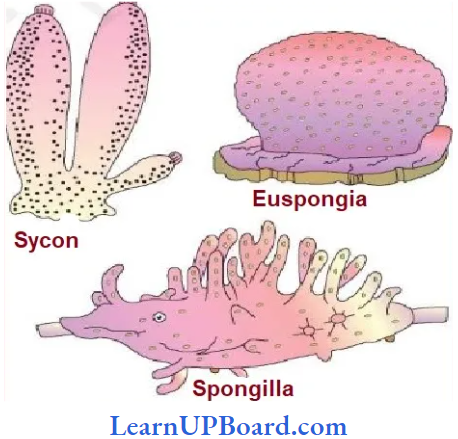
Important Characters Of Phylum Porifera
- Body Wall: The body wall of a common sponge consists of the following layers:
- Pinacodcrm (Dermal Layer): It is the outer cellular layer which consists of
- Flattened pinacocytes and
- Oval porocytes.
- Choanoderm (Gas/Ral Layer): It is the inner cellular layer that consists of highly specialized flagellated cells called choanocytes (collar cells). They are the characteristic cells of this phylum responsible for ingestion of food, secretion of mesohyal, and differentiation of sex cells.
- Mesoltyl Layer (Mesenchyme): Basically, it is a non-cellular layer found between placoderm and choanoderm. It has fine dispersed spongin fibers and numerous spicules. It also contains amoebocytes (amoeba-like cells) of both pinacoderm and choanoderm. Amoebocytes are modified into the following types:
- Archaeocytes: They may be converted into other types of cells and are also called undifferentiated “totipotent ” cells.
- Tropliocytes: They provide food to developing cells and are called nurse cells.
- Thesocytes: They store food granules.
- Gland Cells: They secrete a slimy substance.
- Spongioblasts: They secrete spongin fibers of the mesohyl layer.
- Scleroblasts: They secrete spicules. In calcareous sponges, they are called calcoblasts and in silicious sponges, they are called silicoblasts.
- Collencytes: They secrete collagen fibers and form connective tissue.
- Myocytes: They form a circular ring around the osculum and help in closing and opening of the osculum.
- Germ Cells (sex cells): They form sperms and ova and develop during the breeding season.
- Chromocytes: They contain pigment granules and excretory substances.
- Phagocytes: They collect food from choanocytes through their pseudopodia and also engulf excreta and damaged tissues.
- Pinacodcrm (Dermal Layer): It is the outer cellular layer which consists of
- The central body cavity of a sponge is called a spongocoel or paragastric cavity.
- The continuous water current flowing through the canal system is very important for the life of a sponge. It brings in food and oxygen and carries away carbon dioxide, nitrogenous wastes, and reproductive bodies. Thus, the canal system helps the sponge in nutrition, respiration, excretion, and reproduction.
Phylum Porifera Skeleton: Almost all sponges possess an internal skeleton. It may consist of calcareous or siliceous spicules of fine spongin fibers or both, located in the mesohyl layer.
Phylum Porifera Digestion: It is intracellular and takes place inside food vacuoles as in protozoans.
Phylum Porifera Circulation: The distribution of food from the ingesting cells to others is brought about by wandering amoeba cytes of the mesohyl layer.
In case of Sycon, pinacoderm is divided into exopinacoderm and endopinacoderm. Exopinacoderm lines the incurrent canal and the spongocoel. Radial canals are lined by flagellated choanocytes.
Phylum Porifera Canal System: The body of a sponge is organized in such a manner as to form a complex system of pores and canals. This system is called the canal system. It is meant for food gathering, respiration, and removal of waste. Three types of canal systems are found in sponges:
Ascon Type: It is the simplest type of canal system which is found in Leucosolenia and few other sponges.
” ncert animal kingdom pdf”
Ingressing water → Canal → Spongocoel → Osculum
Sycon Type: It is more complex than the ascon type. It is found in Sycon and some other sponges.

Leucon Type: It is the most complex canal system which is found in Spongilla and some other sponges.

In Demospongiae, the leuconoid condition is derived from a larval stage, called rhagon. It is a conical organism with a flattened base. The canal system of the rhagon larva does not occur in any adult sponge. Because of its derivation from the rhagon stage in Demospongiae, the leucon type of canal system is also called the rhagon type.
Phylum Porifera Respiration: The exchange of gases occurs by diffusion through cell plasma membranes as in protozoans.
Phylum Porifera Excretion: The removal of metabolic wastes also occurs by diffusion through cell plasma membranes as in protozoans. Ammonia is the chief excretory waste.
Phylum Porifera Reproduction: Both asexual and sexual reproduction occur in sponges. Asexual reproduction occurs, by fragmentation, budding, and gemmules. They are hermaphrodites and show internal fertilization.
Phylum Porifera Development: Zygote undergoes holoblastic cleavage (complete division). The development is indirect and includes a free-swimming larva, the amphiblastula (in Sycon), or parenchymula (in Leucosolenia and other porifers) for dispersal of the species.
Classification Of Phylum Porifera: Based on the type of skeleton, phylum Porifera is divided into three classes: Calcarea or Calcispongiae (Gk. Calcis = lime; spongos = sponge—limy sponge), Hcxactinellida or Hyalo- spongiae, and Demospongiae.
Class 1 Calcarea Or Calcispongiae
- The sponges of this class have a skeleton of calcareous spicules. The spicules are of monaxon, triaxon, and tetraxon types.
- The collared flagellated cells (choanocytes) are large.
- These sponges are exclusively marine and found in shallow water.
- Examples: Leucosolenia, Sycon, Grantia.
Class 2 Hexactinellida Or Hyalospongiae
- The sponges of this class have the skeleton for sili¬ceous spicules which are triaxons with six rays.
- Chonocytes are small.
- They are exclusively marine and are mostly found in deep seas.
- Example: Euplectella (Venus flower basket), Hyalonema (glass rope sponge).
- Euplectella lives in a commensal relationship with certain shrimps. Euplectella is given as a precious marriage gift in Japan, symbolizing the idea that “till death we do part.”
Class 3 Demospongiae
- They may contain a skeleton of sponging fibers or of siliceous spicules with sponging liberals or skeletons may be absent. The spicules are either monaxon or tetraxon (may be eight-rayed but never six-rayed).
- Choanocytes are small.
- They occur in marine as well as in freshwater
- Example: Euspongia (bath sponge)—its skeleton is made only of sponging fibers. Spongilla (freshwater sponge), Cliona (boring sponge)—its larva bores into the shells of mollusks, and Chalina (deadman’s fingers or (mermaid’s gloves).
The characteristics of the three classes of phylum Porifera have been tabulated in Table.
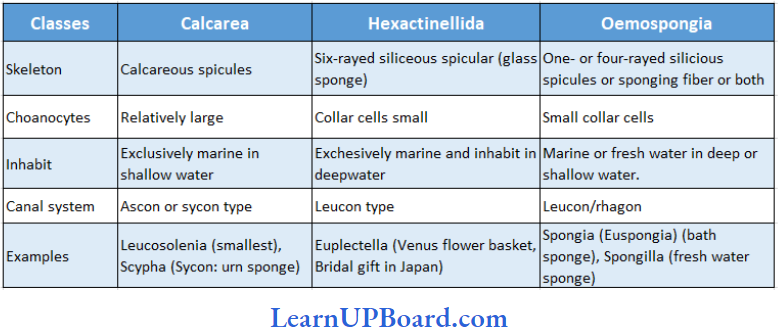
NEET Biology Notes Animal Kingdom Phylum Porifera Points To Remember
Using Sponges: For centuries, people around the world have used natural sponges with spongin skeletons for cleaning, and bathing by taking advantage of the soft flexible, and highly porous bodies of these sponges.
- An example is Euspongia. The ancient Greeks also used sponges as padding inside helmets.
- Spongin fibers are elongated protein fibers that form a fibrous network.
- Digestion in sponges is intracellular.
Sponge cells, separated by straining pieces of sponge through a fine net, can reaggregate and grow into a sponge. So, a sponge is a republic of cells that identify one another, aggregate and grow together.
- Sponge reproduces asexually by fragmentation. During sexual reproduction, some cells become egg or sperm cells. After fertilization, the zygote develops into a flagellated larva which swims, settles in a new place, and grows into a sponge.
- Proterospongia is a connecting link between protozoa and Porifera.
- In Hyalonema, the root tuft consists of a bundle of long anchoring spicules. These may pass through the columella (body axis) as a gastral cone. It is commonly known as a glass rope sponge.
- Euspongia is commonly found is the Mediterranean Sea. It is commonly known as a bath sponge.
- Amphiblastula is the hollow larva of Sycon, etc., whereas parenchymula is the solid larva of most of the sponges, for example, Leucosolenia.
NEET Biology Notes Animal Kingdom Phylum Cnidaria (Coelenterata)
The phylum Cnidaria (old name is Coelenterata) includes about 9000 species, mainly marine. They are sessile, free swimming, radially symmetrical invertebrates, and more complex than sponges. Some examples are Aurelia and Adamsia.
The General Characters Of This Phylum Are As Follows:
- Cnidarians exhibit a blind sac body plan and are radially symmetric. They are more advanced than sponges in having true tissues. They are, however, acoelomate.
- The body wall consists of only two cell layers, ectoderm, and endoderm, separated by a jelly-like mesoglea. These animals are, therefore, diploblastic, that is, arising from two embryonic cell layers.
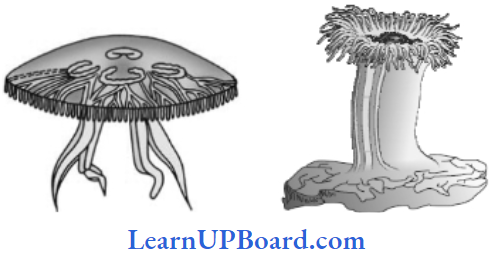
Body Wall In Coelenterates (With Reference To Hydra): They are diploblastic animals, i.e., they are derived from two layers—ectoderm and endoderm. These germ layers form the epidermis and gastrodermis.
- Epidermis: Various epidermal cells are as follows:
- Epithelio-Muscular Cells: Each cell has two functional parts, the outer epithelial part, extending to the body surface and the basal muscular part drawn out into two muscle processes along the longitudinal axis of the body. The muscle processes contain a contractile fibril myoneme.
- Glandulo-Muscular Cells: The epitheliomuscle cells, chiefly in the region of the pedal disc, are specially modified to secrete sticky material for the attachment of the animal to the substratum.
- Interstitial Cells: They are totipotent cells that give rise to all the different cells of the body.
- Sensory Cells: They are scattered throughout the epidermis. They are most numerous on the tentacles, hypostome, and basal disc. They receive and transmit impulses.
- Nerve Cells: They occur for the first time in coelentrates. They are present at the base of epitheliomuscle cells. They conduct impulses in all directions.
- Germ Cells: They remain in restricted regions. They proliferate to form gonads. They are ectodermal in Hydrozoa and endodermal in Scyphozoa and Anthozoa.
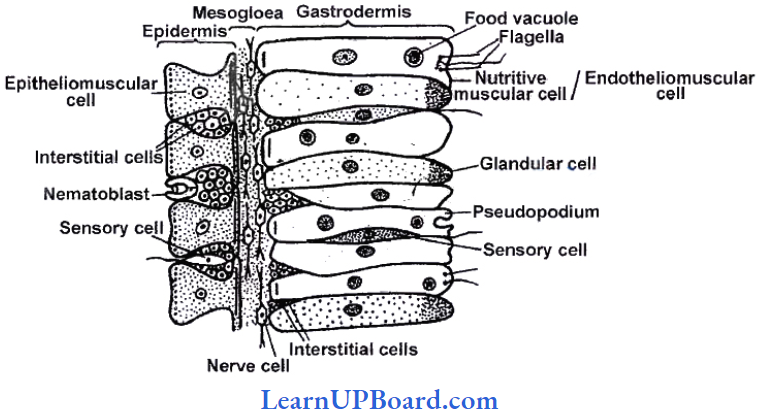
“short tricks for animal kingdom “
Cnidoblasts: Many of the interstitial cells of the epidermis become specialized to form the stinging cells, called the cnidoblasts. They migrate to the tentacles through the mesoglea by means of amoeboid movements. Projecting cnidoblasts act as organs for offense and defense.
Structure Of Cnidoblasts: The cytoplasm of a cnidoblast contains a conspicuous nucleus lying to one side, and a peculiar oval or pyriform sac filled with a poisonous fluid, hypnotoxin. The sac is a part of the stinging apparatus, known as the nematocyst (stinging structure).
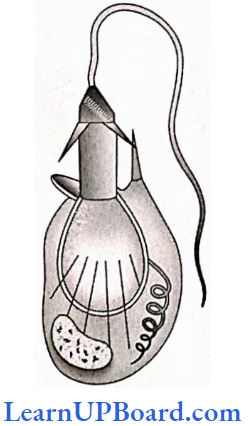
Occurrence Of Cnidoblasts (Nematocysts)
- The nematocysts occur scattered mostly singly, throughout the epidermis of the body, but remain absent on the basal disc.
- They are abundant in the epidermis of the oral region and the tentacles where they cluster as wart-like nematocyst batteries.
Differences Between Four Types Of Nematocysts
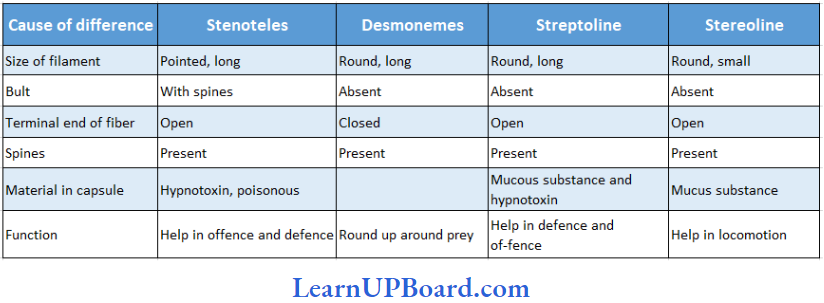
Gastrodermis: It is the inner layer of the body. The cells are of the following types:
- Endothelio-muscle Or nutritive Muscle Cells: They help in the contraction of the body and nutrition.
- Endothelio-gland Cells: They secrete digestive enzymes in the coelenteron. In the region of the hypostome and mouth are found mucous gland cells. Gland cells are absent in the tentacles and basal disc.
- It also contains interstitial cells, sensory cells, and nerve cells but no cnidoblasts.
- They enclose the gastrovascular cavity (coelenteron), having a single-opening hypostome. Their digestion is intra and extracellular.
NEET Biology Notes Animal Kingdom Phylum Cnidaria Points To Remember
The green color of Chlorohydra viridissima comes from the alga Chlorella vulgaris (Zoochlorella), which lives inside the gastrodermal cells of Hydra in a symbiotic relationship. Corattium rubrum (red coral) has been used widely in jewelry and is known as red moon.
Hydra
- Chlorohydra Viridissima (Old Name H. Viridis): Green hydra
- Pelmatohydra Oligactis (Old Name H. Fused): Brown hydra
- Hydra Gangetica: White/pinkish hydra
- Hydra Vulgaris: Colorless hydra
Some Important Characters Of Hydra Are:
- Hydra flourishes well in cool, clean, and stagnant water.
- The number of tentacles surrounding the mouth in Hydra is 6-10. The tentacles of Hydra are hollow while
that of Obelia are solid. - The food of Hydra is water fleas (Daphnia and Cyclops). Thus, it is carnivorous. It cannot digest starch.
- No free larval stage in the development of Hydra. Hence, development is direct.
- Most species of Hydra are dioecious/unisexual.
- Male Hydra bears one to eight conical testes toward the distal end, whereas female Hydra bears one to two rounded ovaries toward the proximal end of the body.
- Locomotion in Hydra occurs by looping, somersaulting, gliding, walking, floating, etc.
Metagenesis And Polymorphism
- Coelenentrata members show polymorphism most commonly is polyp and medusa forms, as mentioned in the table.
- In the life cycle, there is an alternation of the asexual polyp phase and the sexual medusa phase and it is termed as metagenesis.
- During sexual reproduction, medusae liberate gametes into water. Following fertilization, the zygote forms a ciliated larva called planula, which swims, settles, and grows into a sessile polyp. (Some cnidarians such as Hydra do not have a medusa stage. Hydra has no larval form, no metagenesis).
- Polyps reproduce asexually by budding where as medusa liberates gametes into water during sexual reproduction. Both asexual and sexual forms are free living.
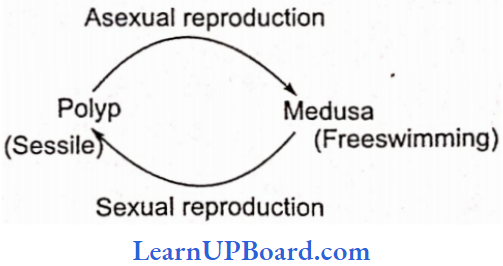
Differences Between Polyp And Medusa Forms
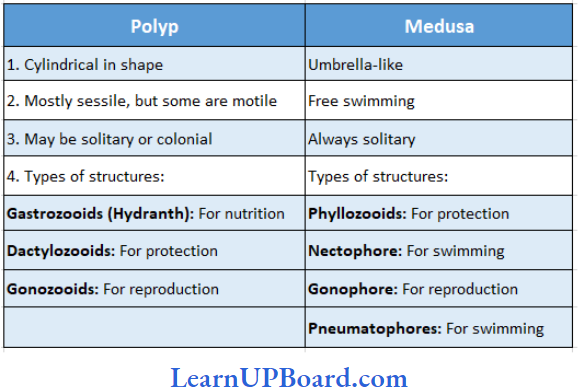
Classification of Phylum Cnidaria: Chiefly on the basis of the dominance of the medusoid or polypoid phase in the life cycle, phylum Cnidaria is divided into three classes as given in Table.
Classification Of Phylum Coelenterata
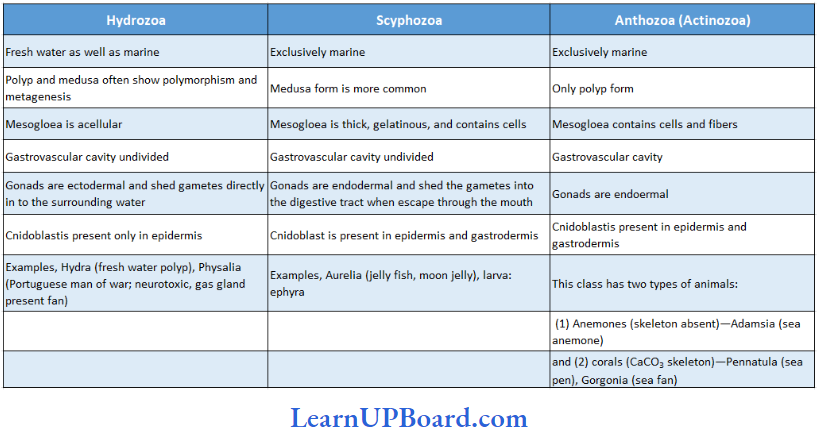
“short trick for animal kingdom “
NEET Biology Notes Animal Kingdom Phylum Coelenterata Points To Remember
Coral Reefs: A coral reef is a ridge or mound in a shallow, tropical sea, has its upper surface near the surface of water, and supports a variety of animals and plants. It is formed of calcium carbonate produced by some of its inhabitants, chiefly medreporarian corals. Coral reefs form stable marine ecosystems. The coral reefs are of three kinds:
- Fringing Reefs: The coral reefs lying close to the shores of some volcanic island or part of some continent are called fringing reefs. Hawaiian islands are an ideal example of permanent flanging reefs.
- Barrier Reefs: They are like the fringing reefs but are located some distance from the shore. The stretch of water of the lagoon separates the barrier reefs from the land. Australia’s Great Barrier Reef is an example of such a reef which is about 900 nautical miles long and 90 miles from sea shore.
- Atoll Reefs: An atoll reef is also called a coral island or lagoon island which is a circular or horseshoe-shaped reef that encircles a lagoon but not an island. It may be complete or broken by a number of channels of which only a few are navigable. The Lakshadweep and Maldives islands in the Indian Ocean are composed of atoll reefs.
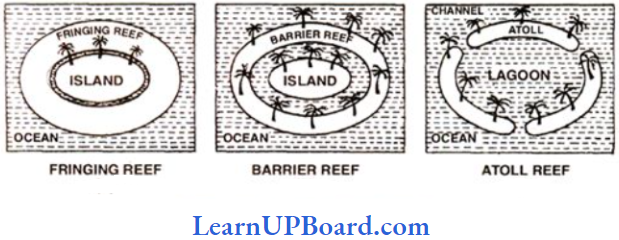
NEET Biology Notes Animal Kingdom Phylum Ctenophora (Sea Walnut Or Comb JelLies)
Ctenophores are exclusively marine, solitary, free swimming or pelagic, very active animals with transparent and flat or oval body shapes and have the following important characteristics:
- Body soft, delicate, transparent, and gelatinous without segmentation.
- Polyp phase is absent in their life cycle, shape is typically spherical, pear-shaped or cylindrical, flat in some.
- They are radially symmetrical, and diploblastic, have a tissue level of organization, and are devoid of cnidoblast cells.
- Tentacles may be present or absent. When present, the number of tentacles is 2. They are solid and possess adhesive cells called colloblasts (lasso cells). Digestion is both extracellular and intracellular. Bioluminescence (the property of a living organism to emit light) is well-marked in ctenophores.
- Animals move by cilia, which join together to form comb plates. There are eight median combplates forming locomotor organs, hence organisms are called comb jellies or sea walnuts.
- The gastrovascular cavity is branched and opens to the exterior by stomodaeum.
They are diploblastic animals, but the mesoglea is different from that of cnidaria; it contains amoebocytes and smooth muscle cells and is comparable to a loose layer of cells. From this viewpoint, ctenophores may be considered as triploblastic.

- Skeletal, circulatory, respiratory, and excretory systems are absent. The nervous system is a diffuse type.
- The presence of a special sense organ statocyst at the opposite end of the mouth (aboral end) is characteristic of the members of this phylum.
- All are hermaphrodite. Testes and ovaries are formed side by side from the endoderm of digestive canals.
- Asexual reproduction does not occur. They reproduce only by sexual means. Fertilization is external. Development is indirect and an immature ciliated stage called cydippid larva is found in some forms.
- Examples: Hormiphora (sea walnut), Pleurobrachia, Ctenoplana, and Cestum (Venus girdle).
NEET Biology Notes Animal Kingdom Phylum Platyhelminthes (Flat Worms)
Phylum Platyhelminthes contains about 13,000 species, mostly parasites that live in other animals including man. The important characters of this phylum are:
- The flatworms are mostly parasites but some are free-living, for example, Planaria.
- They are acoelomate, triploblastic, bilaterally symmetrical, and dorsoventrally flattened animals.
- They have an organ system level of organization.
- The body is not segmented except in class Cestoda (false segmentation).
Body is covered with a cellular, syncytial, single-layered, partly ciliated epidermis, while in parasitic trematodes and cestodes, the epidermis is lacking and the body is covered with a cuticle.
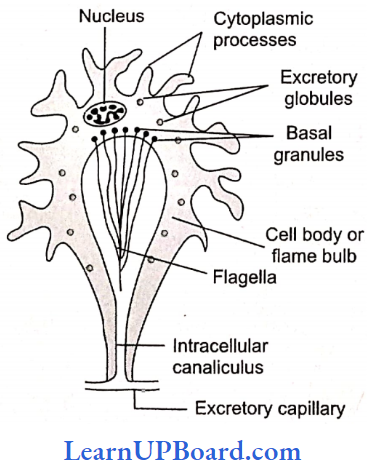
- The exoskeleton and endoskeleton are completely absent. However, hooks, spines, suckers (in parasitic form), teeth, or thorns may be present which act as adhesive organs.
- The space between the body wall, alimentary canal, and other organs is filled with a peculiar connective tissue called the parenchyma. It helps in the transportation of food materials.
The digestive system is totally absent in tapeworms, so they absorb food directly through the body’s surface. In Trematoda and Turbellaria, it consists of mouth, pharynx, and blind intestine (anus absent).
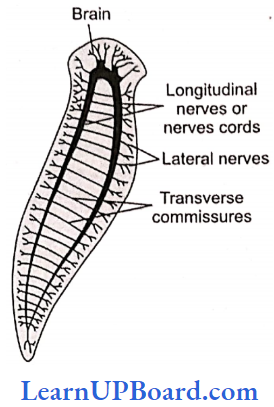
- Respiratory and circulatory systems are absent.
- The excretory system consists of single or paired protonephridium with flame cells.
- The nervous system is primitive. The main nervous system consists of a pair of cerebral ganglia or brain and one to three pairs of longitudinal nerve cords connected to each other by transverse commissures. This type of nervous system is called a ladder-like nervous system, for example, Planaria.
- Sense organs are of common occurrence in Turbellaria but these are greatly reduced in parasitic forms.
- Sexes are united, i.e., hermaphrodite, with very few exceptions such as Schistosoma (blood fluke).
- Asexual reproduction by fission occurs in many freshwater forms such as turbellarians.
- In the majority of forms, eggs are devoid of yolk but provided with special yolk cells and are covered by eggshells.
Cross-fertilization in trematodes and Turbellcria and self-fertilization in cestodes is very common. Fertilization is internal. Development is indirect with many larval stages.

- The life cycle is complicated and involves one or more hosts.
- Regeneration. It is well-marked in some flatworms such as Planaria.
Classification Of Phylum Platyhelminthes: Phylum Platyhelminthes is divided into three classes as given in.
Classification Of Phylum Platyhelminthes
- Turbellaria
- Free-living freshwater or marine known as planarians or Eddy worms.
- The body is unsegmented and the leaf is covered by a delicate ciliated epidermis. Rod-shaped rhabdites in the epidermis.
- The mouth is often ventral and the anus is absent. The alimentary canal is present (branched).
- Reproduction is asexual as well as sexual and shows good power of regeneration; no larva.
- Suckers absent.
- Example, Dugesia(Planaria).
- Trematoda
- Endoparasite, known as flukes, or flatworms.
- Body unsegmented and leaf-like, covered by tegument (fine spines), no epidermis in adult.
- The mouth on the anterior side and anus is absent. The alimentary canal is branched.
- Life history includes larval stages and involves more than one host.
- Suckers are present for attachment in the host.
- For example, Fasciola (sheep liver flukes)
- Causes liver rot disease. Primary host: Sheep and goat Secondary host: Snail (Planorbis, Lymnaea, Bulinus) Shows polyembryony, life-cycle involves miracidium (free-swimming larva), sporocyst, redia, cercaria, and metacercaria larval form.
- Cestoda
- Endoparasite, an intestinal parasite, known as tapeworm.
- Body ribbon-like, covered by tegument. No epidermis in adults.
- Mouth and anus absent (food from body surface). Alimentary canal absent.
- Life history includes larval stages and involves more than one host. Each proglottid has one or two sets of male and female reproductive organs.
- Scolex has suckers and hooks for attachment. The body is divided into scolex, neck, and strobilla of few to numerous proglottids. No true segments.
- For example, Taenia solium (pork tapeworm)
- Primary host = Man (cysticercus in the infective stage).
- Secondary host = Pig (concosphere is the infective stage).
- Shows multiplication in the larva stage, namely, oncosphere, hexacanth, bladderworm, and cysticercus. Causes disease taemiasis or cysticercosis.
NEET Biology Notes Animal Kingdom Phylum Nemathelminthes (Aschelminthes)
The phylum Nemathelminthes includes bilaterally symmetrical, triploblastic, pseudocoelomate animals with organ system grade of organization. They are circular in cross-section.
- They are free-living, aquatic or terrestrial, or parasitic (on plants or animals).
- The excretory system involves an excretory cell (a large giant H-shaped cell) called a renette cell (multinucleated).
- They have a tube-within-tube type of body plan that evolved along the protostome evolutionary line.
- Sexes separate and show sexual dimorphism, internal fertilization, and direct or indirect development.
Classification Of Phylum Nemathelminthes: On the basis of caudal receptors or phasmids, Aschelminthes can be divided into two classes; Aphasmidia and Phasmidia. The characteristic differences between the two classes are given in Table.
Differences Between Classes Aphasmidia And Phasmidia
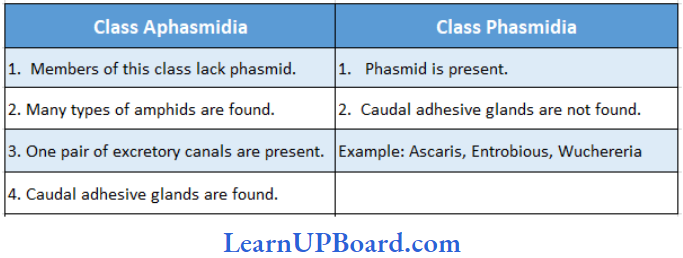
NEET Biology Notes Animal Kingdom Phylum Annelida
The phylum includes over 9000 species of metamerically segmented animals with a true coelom called the schizocoelom.
General Characters Of Phylum Annelida
- The organisms are triploblastic, bilaterally symmetrical, coelomates with organ system level of body organization, and metamerically segmented.
- The body wall has an epidermis of columnar epithelium coated externally by moist albuminous cuticle and with circular and longitudinal muscle fibers.
- Chitinous setae, aiding in locomotion, may or may not be present on fleshy parapodia; absent in leech.
- Annelids are the first animals to have a true schizocoelic coelom. The coelom is divided by septa into compartments.
- The coelomic fluid acts as a hydrostatic skeleton.
- The digestive system is complete and digestion is extracellular.
- Respiration occurs by moist skin (cutaneous respiration) or through gills (branchial respiration).
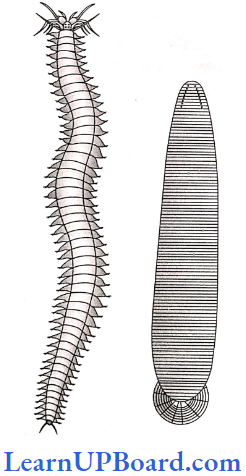
The blood vascular system is usually closed. Respiratory pigments, either hemoglobin or erythrocruorin. are dissolved in blood plasma. Free amoeboid blood corpuscles are present, but there are no RBCs. In leech, there is no true blood vascular system.
- Nephridia are excretory organs. Ammonia is the chief excretory waste.
- The nervous system consists of a nerve ring and a solid, double, mid-ventral nerve cord with ganglia and lateral nerves in each segment.
- Sensory organs include tactile organs, taste buds, statocysts, photoreceptor cells, and eyes with lenses.
- The sexes may be separate (for example, Nereis) or united (for example, earthworm, leech).
- Development is mostly direct (for example, earthworm). There is indirect development in Nereis. Larva, when present, is trochophore.
Classification Of Phylum Annelida
Class 1 Archiannelida: All members are marine and small, segmentation is mainly internal, and no parapodia or setae. The trochophore larva stage is present. Examples are Dinophilus and Polygorclius.
Class 2 Polychaeta
- Almost all members are marine and occur in great abundance near the seashore. The head is distinct with eyes, palps, and tentacles.
- Locomotory structures are parapodia with setae; a clitellum is never developed.
- Sexes separate, trochophore larva is present which undergoes metamorphosis to reach the adult stage during development.
- The sexual stage of Nereis is called heteronereis. It has its body differentiated into anterior atoke and posterior epitoke. The epitoke is provided with foliaceous parapodia and gonads.
Class 3 Oligochaeta
- Commonly called “earthworms.” Mostly terrestrial, some are found in fresh water too.
- A well-marked head is absent. Parapodia are absent.
- A clitellum is generally present main function being cocoon formation.
- Hermaphrodites, fertilization external, development direct, no larval stage, and therefore, no metamorphosis. Chloragogen cells in earthworms help in excretion.
- Septal and pharyngeal nephridia will help in the conservation of water.
- Examples: Tubifex, Megascolex (South Indian earthworm). Lumbricus is a European earthworm, not found in India.
Class 4 Hirudinea
- Commonly called “leeches,” ectoparasites, and body with a fixed number of segments, i.e., 33.
- Each segment is subdivided into annuli; parapodia and setae are absent; body with two suckers.
- Suctorial mouth, sanguivorous (feeding on blood).
- Coelom is reduced by botryoidal tissue; a connective tissue supposed to be excretory.
- Circulation open type with hemocoelic system.
- A temporary clitellum is present. They are mostly aquatic. Leeches secrete anticoagulant “hirudin” from salivary glands which do not allow blood clotting of the host.
- Locomotion is by looping and swimming.
- They are hermaphrodites; with no larval stage or metamorphosis. Fertilization is internal but embryos develop inside a well-formed cocoon.
- Examples: Hirudo, Hirudinaria, Pontobdella.
Class 5 Echiurida: These annelids are without external and internal segmentation. Setae are rare; usually, they have long prostomium. Examples are Bonellia and Echiuris.
Nereis
- Inhabits in sea shore between tide mark; burrower, nocturnal, carnivorous, gregarious, fertilization in the sea.
- Parapodia in each segment except first and last.
- During breeding, the body divides into two parts. Anterior asexual partatoke and posterior sexual portion epitoke. This change is known as epitoky.
NEET Biology Notes Animal Kingdom Phylum Arthropoda
Phylum Arthropoda is the largest phylum in the animal kingdom, including 900,000 species. The largest class is Insecta with 750,000 species. The general characters of this phylum are:
- They are triploblastic, coelomate, and bilaterally symmetrical animals. The body cavity is full of hemolymph (blood) and it is known as hemocoel. The true coelom is restricted to gonads.
- The body is covered by a chitinous cuticle, which forms the exoskeleton which is shed at intervals, i.e., it undergoes molting/ecdysis.
- They have a segmented body, each segment bearing a pair of jointed appendages covered by a jointed exoskeleton. The chitinous exoskeleton is secreted by the underlying epidermis.
- The body is divided into the head, thorax, and abdomen. In some cases, the head and thorax is fused to form a cephalothorax. In insects, the thoracic segments have legs and wings; the abdomen has no legs in insects.
- Respiratory organs are the gills, book gills, book lungs, or tracheal system.
Excretion takes place through green glands or Mal-pighian tubules since nephridia are absent.
- Sensory structures in arthropods are antennae for perceiving odor, eyes, statocysts or balance organs, and sound receptors (in chirping crickets and cicadas). Eyes are simple or compound. In honey bees, butterflies, moths, and some other insects, the gustatory receptors are present on their feet.
- The heart is dorsal and the circulatory system is open.
- The central nervous system consists of paired pre-oral ganglia connected by commissures to a solid double ventral nerve cord.
- In Inland arthropods, fertilization is always internal.
- Arthropods are mostly dioecious, and oviparous. In some arthropods such as the scorpion, the eggs hatch within the female body. They bring forth the young ones alive. They are viviparous. Development is direct or indirect.
Advancement Over Annelida
- Distinct head in all species.
- Jointed appendages serve a variety of functions.
- Jointed exoskeleton for protection and muscle attachment.
- Striped muscles are arranged in bundles for moving particular body parts.
- Special respiratory organs such as gills, trachea, book lungs, etc., in the majority of cases.
- Well-developed sense organs such as compound eyes, statocysts, auditory organs, taste receptors, etc.
- Endocrine glands and pheromone secretion for communication.
Classification Of Phylum Arthropoda: The phylum Arthropoda is divided into five classes.
Class 1 Crustacea
- The body is divisible into cephalothorax (head + thorax) and abdomen.
- Dorsally, the cephalothorax is covered by a thick exo-skeletal carapace.
- There are present two pairs of antennae and a pair of stalked compound eyes and biramous appendages.
- Respiration is earned out either by the body surface or by gills.
- Excretion takes place usually by antennary glands (green glands).
- Sexes are usually separate. Sexual dimorphism is also seen.
- Development is usually indirect.
- Examples: Palaemon (prawn), Macrobrachium (prawn), Astacus (crayfish), Palinurus (lobster), Cancer (crab), Lucifer (shrimp), Eupagurus (hermit crab), Oniscus (woodlouse, terrestrial), Daplwia (water-flea), Cyclops, and Balanus (barnacle). Tiny crustaceans such as Daphnia and Cyclops act as zooplanktons which form important links in the food chain in water.
Class 2 Chilopoda
- The body is long, segmented, and divisible into head and trunk.
- Each trunk segment bears a pair of legs. The first pair of legs is modified into poison claws.
- There is a single pair of antennae and ocelli.
- Many legs are present.
- Respiration occurs by tracheae.
- Excretion takes place by Malpighian tubules.
- Development is direct
- Examples: Scolopendro.
Class 3 Diplopoda
- The body is divided into the head, thorax, and abdomen.
- There is a single pair of antennae and ocelli.
- Except for the first thoracic segment (if does not have legs), each thoracic segment bears a pair of legs; however, each abdominal segment has two pairs of legs.
- Respiration occurs by tracheae.
- Excretion takes place by Malpighian tubules.
- Development is generally direct, for example, Julus.
Class 4 Insecta (Hexapoda)
- The body is divided into the head, thorax, and abdomen.
- There is a pair of antennae and a pair of compound eyes.
- The thorax consists of three segments with three pairs of legs and usually two pairs of wings. For example, mesothoracic wings which are thick and leathery are called tegmina, and metathoracic wings are membranous (in cockroaches). Wings may be absent in the same insects.
- The abdomen may consist of 10 segments.
- Respiration usually takes place by tracheae (no respiratory pigments).
- The heart is tubular and divided into chambers.
- Malpighian tubules are the excretory organs. Uric acid is the chief excretory waste.
- Sexes are separate.
Development may be direct or indirect, for example, silverfish, cockroaches, bedbugs, locusts, termites, butterflies, rat fleas, beetles, wasps, aphids, glowworms, etc. A maggot is the larva of a housefly.
Insects communicate with each other by ectohormones called pheromones. Pheromones are chemicals secreted outside the body and perceived as smell by other individuals of the same species. They help in communication amongst the organisms of the same species.
Class 5 Arachnida
- The body is usually divisible into cephalothorax and abdomen.
- The cephalothorax bears simple eyes and six pairs of appendages (one pair of chelicerae, one pair of pedi- palp, and four pairs of legs).
- Antennae are absent.
- Respiratory organs are book lungs or tracheae or both.
- Excretion takes place by Malpighian tubules coxal glands or both.
- Development is generally direct.
- Examples: Tick, mite, Aranaeus (garden spider), Palamneus (scorpion), Buthus (scorpion).
- Spiders spin webs by means of proteinaceous secretions of abdominal glands known as “spinnerets.”
- There are two more classes in the phylum Arthropoda. These classes are Onychophora and Merostomata.
- Peripatus is an important example of the class Onychophora which has the characters of phylum Annelida and Arthropoda. Hence, it is called a “connecting link.” Umulus, (king crab or horseshoe crab) is an example of the class Merostomata which respires with book gills.
- The king crab is called a “living fossil.” A living fossil is a living animal of ancient origin with many primitive characteristics.
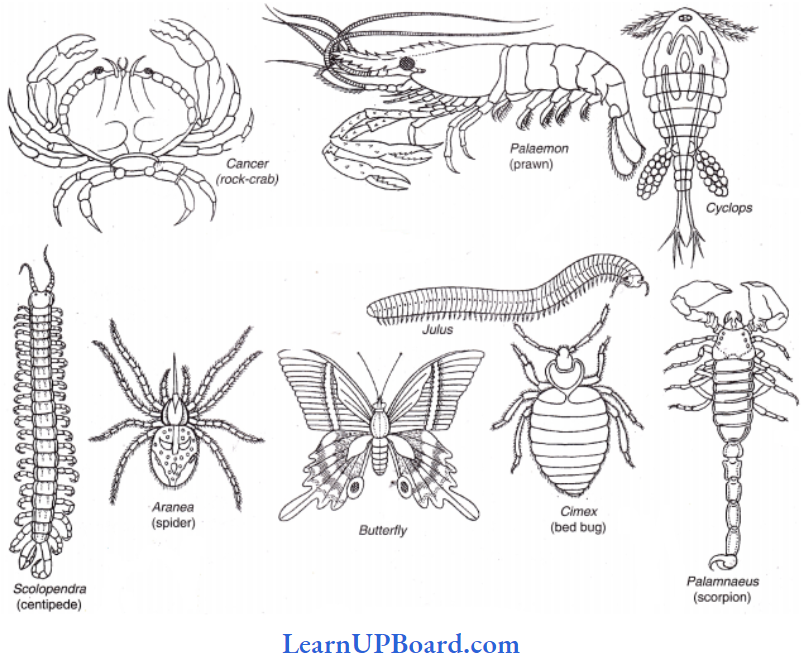
NEET Biology Notes Animal Kingdom Phylum Arthropoda Points To Remember
- Peripatus is considered as a connecting link between Annelida and Arthropoda as it has unjointed legs and breathes by the trachea.
- Larvae of different arthropods:
- Bombyx (silkworm)—Caterpillar/silkworm.
- Beetles—honey bee grub
- Musca (housefly)-Maggot
- Culex, Anopheles-Wriggler
- Pennaeus (marine prawn), Mysis, Nauplius—Protozoea
- Cancer (Crab)—Megalopa, metanauplius, zoea
- Terga are dorsal plates whereas sterna are ventral plates of exoskeleton.
- Arthrodial membranes join different sclerites.
- Halters are drumstick-shaped, second pair of reduced wings of houseflies and mosquitoes which help in balancing.
- The eggs of Culex are cigar-shaped; they are laid vertically on the surface of water in clusters; airfloats are absent; whereas in Anopheles, eggs are boat-shaped, laid singly and horizontally; they have airfloat.
- The larva of Culex is the bottom feeder whereas the larva of Anopheles is a surface feeder.
- The adult of Culex lies parallel to the surface and both ends of the body are deflexed whereas m Anopheles, the body is inclined at an angle of 45° to the surface. So, they can be distinguished with the help of sitting posture.
- In spiders, spinnerets are present anterior to the terminal anus. They produce silken thread.
- Von Frisch described the process of communication of food sources in honey bees.
- Insecticides sprayed over the mosquitoes desensitize their nervous system as well as the chemoreceptors and mechanoreceptors of the antennae.
- Johnston’s organs are present on the antennae of mosquitoes.
- The life cycle is generally accompanied by metamorphosis. Larvae and adults may show different feeding habits and occupy different habitats.
- Insects such as bees, wasps, beetles, moths, and butterflies are good pollinators for important crops.
- Ants, termites, and locusts are eaten by Chinese and Indians; the eggs of aquatic bugs are used as food by Mexicans; ox-warbles are eaten by Red Indians.
- Dragonflies feed on the larvae of mosquitoes
- Glow womb (firefly) shows bioluminescence.
- Adult Ctrier and Anopheles can be distinguished with the help of sitting posture.
The insects may be divided into five groups on the basis of their mode of development.
Ametabola Insects: Metamorphosis absent. The young ones resemble adults.
Eggs → Young → Adult
Example: Lepisma (silverfish)
Paurometabola Insects: Gradual metamorphosis.
Eggs → Nymph → Adult
Examples: Cockroaches, grasshoppers, locusts, etc.
Hemimetabola Insects: Incomplete metamorphosis. Habitat of young ones is different from adults.
Eggs → Naiads → Adult
Example: Dragonflies (naiads aquatic but adults aerial)
Holometabola Insects: Complete metamorphosis.
Eggs → Larva → Pupa → Adult
Examples: House flies, butterflies, mosquitoes, etc.
Hypermetabola Insects: Various forms of larvae.
Eggs → Larva (1) → Larva (2) → Pupa → Adult
Example: Blister beetle.
NEET Biology Notes Animal Kingdom Phylum Mollusca
Phylum Mollusca is the second largest phylum in the animal kingdom which includes over 60,000 species. The general characters of this phylum are as follows: Molluscs are terrestrial, aquatic (freshwater or marine) triploblastic, bilaterally symmetrical, schizocoelici, and unsegmented animals.
- Most mollusks secrete a shell of calcium carbonate that protects and supports their soft tissues.
The body is organized into three general regions: head, foot, and visceral hump. - The visceral hump contains the digestive tract and other visceral organs.
- The body is covered by a soft and spongy skin fold called a mantle which secretes the shell.
- The space between the hump and the mantle is called the mantle cavity in which feather-like gills are present.
- Molluscs typically employ a feeding organ called radnla which is armed with rows of chitinous teeth. The radula protrudes from the mouth and works back and forth to rasp the food into fine particles.
- The circulatory system is mainly of open type but some reduced sinuses are present. The respiratory pigment is hemocyanin.
- Respiration occurs by feather-like gills, pulmonary sacs, or both, or through the general body surface.
- Excretion occurs by the paired organ of Bojanus. Another excretory organ called Keber’s organ (pericardial gland) is also present in Unio along with the paired organ of Bojanus. It pours the waste into the pericardium from where the waste is carried to the organ of Bojanus that opens out through the mantle cavity.
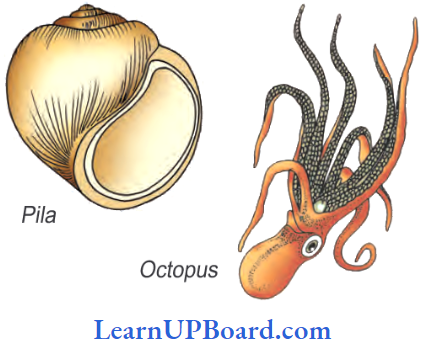
Sense organs include eyes, statocysts, and osphradia (chemoreceptors to test the chemical nature of water).
- Reproduction sexual, adults can be dioecious (unisexual) or monoecious (bisexual or hermaphrodite). Fertilization is generally external; development is direct or through free larval forms such as trochophore, veliger (in Pila), glochidium (in Unio)—an ectoparasite on fishes. Pila produces two types of sperms:
- Eupyrene: Motile and functional sperms, 25 pm long, thread-like with a single cilium.
- Oligopyrcne: Non-motile and non-functional sperms, 32.5 pm long, spindle-shaped with 4-5 cilia.
Classification Of Phylum Mollusca: The classification of Mollusca is mainly on the basis of shell and foot.
Class 1 Monoplacophora
- The flattened, bilateral, and oval body has some annelidan characters. For example, some internal organs exhibit metameric segmentation. There are also present nephridia. However, these animals are mollusks because they have the characteristics of the phylum Mollusca.
- Their body is enclosed in a mantle which secretes a dome-shaped outer shell.
- A broad and flat muscular foot is present for locomotion. Sexes are separate.
- Example: Neopilina galathea, the most primitive mollusk, has the characters of annelids. A “living fossil” and a connecting link between annelids and mollusks. It is the only mollusk that has a segmented body and is covered with a shell.
Class 2 Polyplacophora/Amphineurs
- They are all marine.
- They are bilaterally symmetrical with elongated bodies having mouth and anus at opposite ends.
- The head lacks eyes and tentacles.
- The ventral surface has a flat foot.
- The shell may consist of one to eight plates.
- Examples: Chiton (coat of mail shell), Chaetopleura (chiton)
Class 3 Scaphopoda
- They are marine and burrow in mud and sand.
- They are bilaterally symmetrical with tubular shell openings at both ends.
- The Head has many prehensile tentacles.
- The foot is conical and used for digging.
Class 4 Gastropoda
- Gastropoda is the largest class of mollusca comprising limpets, slugs, snails, etc. A characteristic feature that distinguishes all gastropods from other mollusks is torsion.
- They are terrestrial, freshwater, and marine forms.
- The shell is made of one piece enclosing the visceral mass.
- The hand is distinct and has eyes and tentacles.
- The foot is flat and muscular.
- The buccal cavity has an odontophore with a radula bearing chitinous teeth.
- There is present a veliger larva during development.
The early embryo is symmetrical with an anterior mouth and posterior anus but during development, the body twists, bringing the anus near the mouth, showing torsion so that it becomes asymmetrical. Thus, in the adult forms, the mouth and anus are both anterior.
Examples: Pila (apple snail), Aplysia (sea hare), Doris (sea lemon), Patella, Umax (grey slug, slowest invertebrate terrestrial), Achatina (land snail).
Class 5 Pelecypoda (Bivalvia)
- Pelecypods include clams, mussels, oysters, scallops, and related bivalve mollusks.
- The body is laterally compressed and enclosed in a bivalve.
- No head, tentacles, eyes, jaws, or radula.
- Food is often hatchet-shaped and extends between mantle lobes.
- Mostly filter feeders. Usually dioecious, veliger, or glochidium larvae are present during development.
- Mostly marine, few freshwater forms.
- Examples: Unio (freshwater mussel), Mytilus (sea mussel), Teredo (shipworm), Pecten (scallop), Spon-dylus (edible oyster), Pinctada (pearl oyster), Solen (razor clam), Ostrea (pearl oyster), Lamellidens (mussel).
Class 6 Cephalopoda (Siphonopoda)
- Cephalopods are exclusively marine.
- Cephalopoda contains the most specialized molluscs including squids, octopods, cuttlefish, and nautiloids (living fossils).
- They are the most active mollusks, the foot is located on the head, modified in the form of oral arms.
- Nautilus has an external shell but in others, the shell has been reduced and enclosed within the body or lost entirely.
- The head is distinct and large with well-developed eyes.
- It is surrounded by a ring of tentacles.
- Part of the foot forms a funnel-shaped siphon.
- Locomotion is by expelling water in jets through siphons (jet propulsion).
- Ink glands are present in some squids for offense and defense.
- When the squid is attached, it emits a cloud of inky fluid through its siphon.
- This “smoke screen” interferes with the visual and chemoreceptors of the predator and thereby helps the squid to escape.
- Examples: Sepia (Cuttlefish), Loligo (squid or sea arrow), Octopus (devilfish), Nautilus, Spirula (spiral shell), Architeuthis (giant squid), etc.
NEET Biology Notes Animal Kingdom Phylum Mollusca Points To Remember
Architeuthis (giant Atlantic squid) is the largest and heaviest among invertebrates, 55 feet in length. Nautilus is the only cephalopod with an external shell, so ink glands are absent. The color change in cephalopods occurs due to chromatophores.
NEET Biology Notes Animal Kingdom Phylum Echinopermata
Echinoderms are exclusively present in marine water and there are no parasitic forms. Similarities with chordates are as follows:
- They have a tube-within-tube type of body plan which has evolved along the deuterostome evolutionary line.
- They possess a true coelom called enterocoelom.
- They have mesodermal skeletons made of calcareous plates or ossicles.
All these characters make echinoderms closer to chordates. The other characters are:
- The symmetry is bilateral in larvae, but pentamerous radial in adults.
- Many echinoderms bear a number of calcareous spines on their body surfaces called tubercles. Between the spines, there are pincer-like structures called pedicellariae to keep the surface clean. Pedicellariae are made of three calcareous plates. Two calcareous valve-like structures in the form of aws rest upon a basal calcareous plate.
- Between the spines, there are finger-like processes called dermal branchiae which help in respiration. The mouth is on the ventral/oral side and the anus is on the dorsal or aboral side.
- There is no distinct anterior and posterior end, i.e., no cephalization.
Hemal and peripheral systems: Instead of a blood vascular system, there are present hemal and peripheral systems that are of coelomic origin. Thus, the so-called circulatory system is open type. The so-called blood is often without a respiratory pigment. There is no heart.
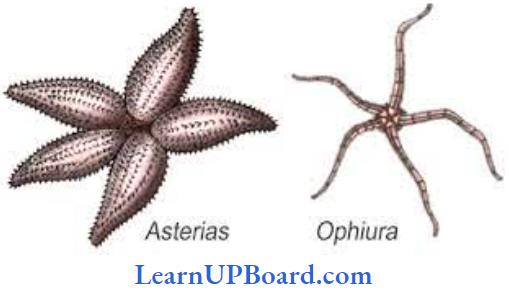
- Respiratory Organs: Gaseous exchange occurs by dermal branchiae or papulae in starfishes, peristominal gills in sea urchins, genital bursae in brittle stars, and cloacal respiratory trees in holothurians. The exchange of gases also takes place through tube feet.
- Excretory Organs: Specialized excretory organs are absent. Nitrogenous wastes are diffused out via gills or dermal branchiae. Ammonia is the chief excretory matter.
- Sexes are separate. Reproduction is sexual. Fertilization is usually external. Development is indirect with free-swimming larvae.
Classification Of Phylum Echinodermata: Phylum Echinodermata is divided into five classes.
Class 1 Asteroidea (Gk: Aster = star, eidos = form)
- The body is flat and star-like.
- Five anns are usually present which are not sharply marked off from the central disc.
- Autonomy: The ability of starfish to break off a part of its body, followed by regeneration.
- The oral surface has mouth and ambulacral grooves.
- The aboral surface bears the anus and madreporite.
- Respiration by dermal branchiae and tube feet.
- Spines are short.
- Pedicellariae are present.
- Larvae of starfish are pleura, bipinnaria, and brachiolaria.
- Examples: Asterias (starfish), pentaceros (starfish), and Astropecten (starfish).
Class 2 Ophiurodea (Gk: Ophis = snacks, oura = tail, eidos = form)
- The body is flat and star-like.
- Arms are sharply marked off from the central disc.
- The oral surface has a mouth and madreporite.
- Anus and ambulacral grooves are absent.
- Spines are short.
- Pedicellariae are absent.
- Larva is ophiopluteus.
- Examples: Ophiothrix (brittle star), Ophioderma (brittle star), Ophiocoma (brittle star), and Ophiura (brittle star).
Class 3 Echinoidea (Gk: Echino = hedgehog, eidos = form)
- The body is globular or disc-like.
- Arms and ambulacral grooves are absent.
- The oral surface has a mouth.
- A biting and chewing apparatus with teeth called Aristo¬tle’s lantern is present.
- The aboral surface bears the anus and madreporite.
- Spines may be small or large.
- Pedicellariae are present.
- Larva is echinopluteus.
- Examples: Echinus (sea-urchin), Clypeaster (cake urchin), Echinarachinus (sand dollar), and Echinocordium (heart urchin).
Class 4 Holothuroidea (Gk: Holothurion = sea cucumber, eidos = form)
- The body is elongated and cylindrical.
- Arms are absent.
- The oral end has a mouth surrounded by tentacles.
- The aboral end has an anus.
- Madreporite is internal.
- Ambulacral grooves, spines, and pedicellaria are absent.
- Larva is auricularia.
- Examples: Holothuria (sea cucumber), and Cucumaria (sea cucumber).
Class 5 Crrinoidea (Gk: Crinon = lily, eidos = form)
- The body has a central disc which is attached to the substratum
- Arms are breached with pinnules
- The oral surface has a mouth and anus.
- Ambulacral grooves are present.
- Spines, Pedicellariae, and madreporite are absent.
- They are commonly called feather stars or sea lilies.
- Larva is doliolaria.
- Examples: Antedon (sea lily; feather star).
NEET Biology Notes Animal Kingdom Phylum Echinopermata Points To Remember
The starfish uses the suction-cup-like ends of the tube feet of one arm to hold on to rocks, as it moves the other anus. It can open bivalves (mollusks) by attaching two anus to either side of a bivalve and pulling them apart.
- The bivalve opens out; the stomach of starfish is then everted through its mouth and introduced into the open mollusc which is partly digested before being ingested.
- Echinodenns predate on coral polyps also.
NEET Biology Notes Animal Kingdom Phylum Hemichordata Or Stomochordata
Hemichordata was earlier considered as a sub-phylum under chordata. But now it is placed as a separate phylum under non-chordata.
The phylum consists of a small group of worms-like marine animals with an organ system level of organization. Its characteristics are:
- In hemichordata or stomochordata, true notochord is absent. Gill slits are present but they are dorso lateral in position. They are worm-like, bilaterally symmetrical, Triploblastic, and entero-coelomate animals.
- Stomochord is a hollow outgrowth arising from the roof of the buccal cavity, also called a buccal diverticulum. It is present in the proboscis.
- Dorsal heart, ventral hollow nerve cord, and no respiratory pigments. The circulatory system is open. Respiration occurs by the gills.
- Development is mostly indirect through a free-swimming tomaria larva, for example, Balanoglossus (acorn, tongue worm), or Glossobalanus. Sexes are separate. Fertilization is external.
- Believed to be a connecting link between non-chordates and chordates.
- Due to the absence of true notochord in hemichordata, many taxonomists do not consider these animals as chordates.
- Excretory organ is proboscis gland.
- The body is cylindrical and is composed of an anterior proboscis, a collar, and a long trunk.
- Examples: Balanoglossus, Saccoglossus
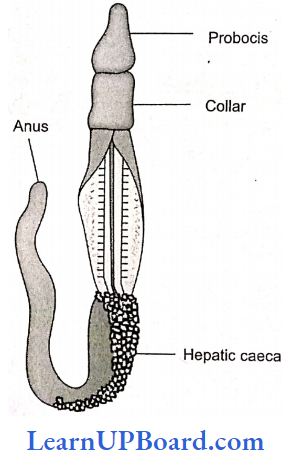
NEET Biology Notes Animal Kingdom Phylum Chordata
The Most Important Characteristics Of Phylum Chordata Are:
- They possess a notochord either throughout life or during early embryonic development.
- Dorsal hollow nerve cord.
- Paired gill slits on the lateral sides of the pharynx.
- Post anal tail.
- Closed circulatory system.

Sub-Phylum Protochordata Or Acraniata
Sub-Phylum 1 Urochordata
- They are exclusively marine.
- This sub-phylum is also called Tunicata because the adult body is enclosed within a leathery test or tunic formed of a cellulose-like organic substance termed tunicin.
- The larva (Ascidian tadpole) undergoes retrogressive metamorphosis, i.e., change from a better-developed larva to less developed adult, for example, Herdmania (sea squirt).
- Vanadocytes are present except in Herdmania. Vanadium gives a green color to blood. Excretion occurs by the neural gland, hence excretion is glandular.
- Examples: Salpa, Doliolum, Ascidia.
Phylum Chordata Can Also Be Divided As:
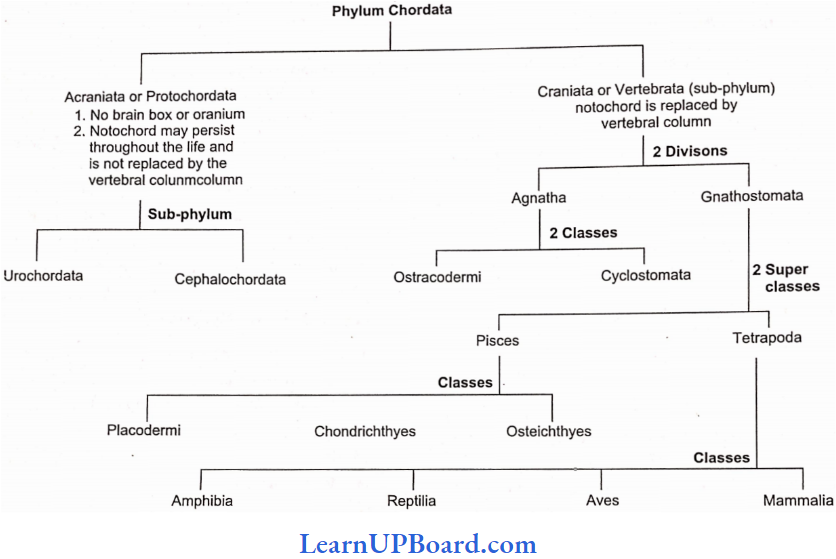
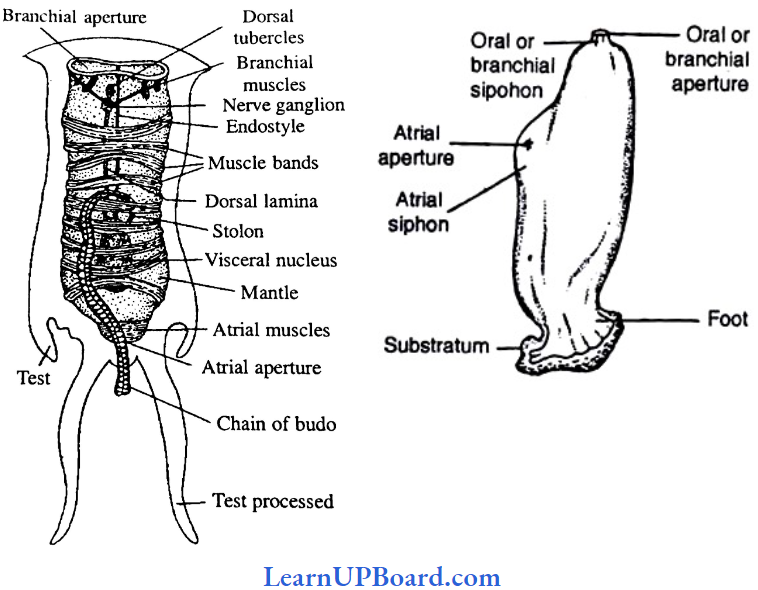
Sub-Phylum 2 Cephalochordata
- The notochord extends up to the anterior end of the body. Hence, this sub-phylum is named so.
- The tail is present throughout life, for example, Brcmchiostoma (Amphioxus).
- AmphioxusiBrcmchiostoma has both ends pointed like a lance. Hence, it is commonly called a lancelet.
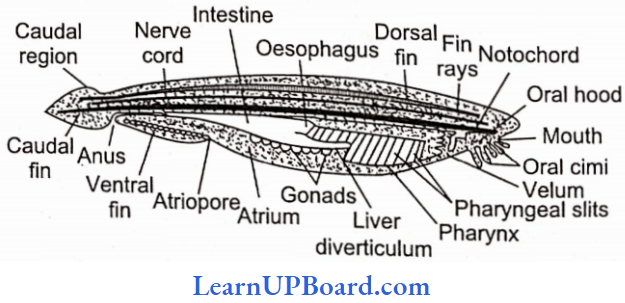
Sub-Phylum Vertebrata Or Craniata
- These are advanced chordates that have a cranium (cartilage or bony brain box) around the brain.
- Notochord is present only in the embryonic stages. It is replaced by a cartilaginous or bony vertebral column (backbone) in the adult forms. They have paired appendages as fins and limbs.
- A closed circulatory system is present; a muscular and ventral heart with two, three, or four chambers; a lymphatic system is present; erythrocytes and hemoglobin are present.
- A pair of kidneys is present for excretion and osmoregulation; endocrine glands are well-developed; members are generally unisexual and have a single pair of gonads.
Phylum Chordata Division 1 Agnatha (Jawless Vertebrates)
- They are the most primitive of all craniates.
- The mouth does not possess jaws, hence named Agnatha.
- The vertebral column is represented only by small imperfect neural arches over the notochord.
- They do not have exoskeletons and paired appendages.
- They have a single nostril. The internal ear has one or two semicircular canals.
- They are cold-blooded.
- It includes two classes: Ostracodermi and Cyclostoinata.
Class 1 Ostracodermi
- Ostracoderms are all extinct now and are called fossil agnatha.
- These were shell skinned with an exoskeleton of bony plates, for example, Cephalaspis.
- They were the first jawless fishes (originated in the Ordovician period in the Palaeozoic era).
Class 2 Cyclostomata: Its general characters are as follows:
- All living members of the class Cyclostomata are ectoparasites on some fishes. The body is devoid of scales and paired fins. The head and brain are poorly developed. They are also called jawless fishes.
- Cyclostomes have an elongated body bearing 6-15 pairs of gill slits in their gill pouch for respiration and have a sucking and circular mouth.
- Single-sex organ discharges gametes in the well-developed coelom.
- The cranium and vertebral column are cartilaginous with persistent notochord.
- The stomach is absent.
- A single dorsal nostril leads into a closed nasal sac. A functional pineal eye is present just behind it.
- Circulation is of closed type.
- Kidneys are mesonephric.
Differences Between Lamprey And Hagfish
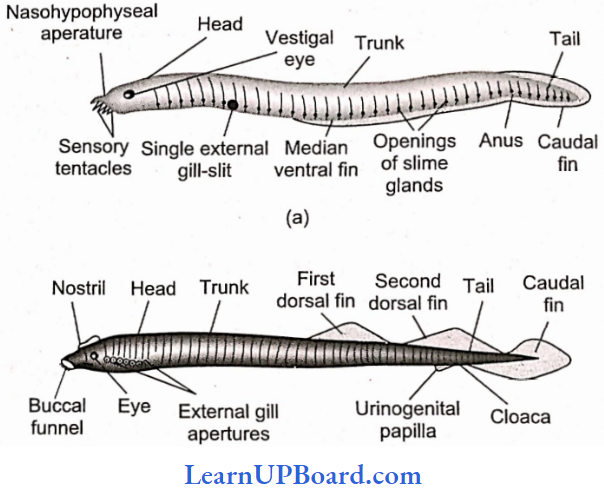
Phylum Chordata Division 2 Gnathostomata (Jawed Vertebrates)
- It includes advanced vertebrates.
- The embryonic notochord is usually replaced in adults by a vertebral column.
- Paired fins or limbs are present.
- The mouth has jaws, hence it is named gnathostomata.
- Paired nostrils are present.
- The internal ear has three semicircular canals. Girdles are present.
- Gnathostomata is divided into two superclasses: Pisces and Tetrapoda.
Super Class 1 Pisces: Pisces includes true fishes. All are aquatic. The body bears fins. They are cold-blooded. The characteristics are as follows:
- Monocondylic skull; slimy glands present on skin.
- Vertebrae are amphicoelous types.
- Neck absent, no upper or lower eyelids, no tympanum (only internal ear is present). Each eye has a well-developed nictitating membrane.
- Heart two-chambered (S-shaped); venous heart with sinus venosus and conus arteriosus.
- Both renal portal and hepatic portal systems are found. A hypophyseal portal system is also present.
- Respiration occurs typically by gills.
- Scales are mesodermal or dermal and embedded in the skin.
- Kidneys are mesonephric and ammonotelic (sharks: ureotelic).
- Lateral line sense organs are present.
Super class Pisces is divided into three classes: Placodermi, Chondrichthyes, and Osteichthyes.
Class 1 Placodermi (Extinct): It includes the earliest fossil fishes that lived in freshwater. The body had an external protective armor of bony scales or plates. Primitive jaws with teeth were present. The skeleton was bony. Fins were mostly formed of large spines, for example, Climatius (spiny shark).
- They appeared in the Silurian period, flourished in the Devonian and Carboniferous periods, and became extinct in the Permian period.
- The name placodermi means “armored fish” or “plate skinned.”
- Both paired and unpaired fins were present. Caudal fin heterocercal.
- Autostylic jaw suspension; gill slits are covered by operculum.
Class 2 Chondrichthyes: This class includes cartilaginous fish, for example, Scoliodon (dogfish), Torpedo (electric ray), etc.
Sharks are fast-swimming predators, whereas the rays and skates are stout, bottom-living scavengers and mollusk feeders.
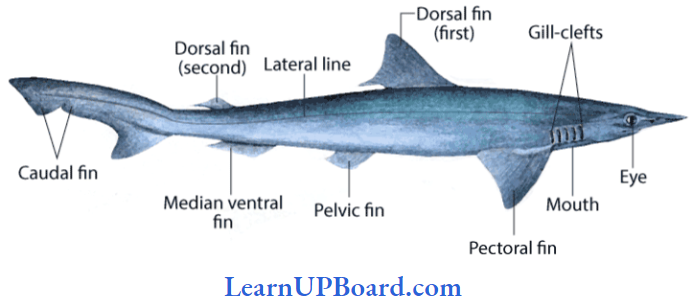
Class 3 Osteichthyes: It includes bony fishes, for example, Labeo, Hippocampus, Exocoetus, Catla, Clarias, Betta, Pterophyllum, etc.
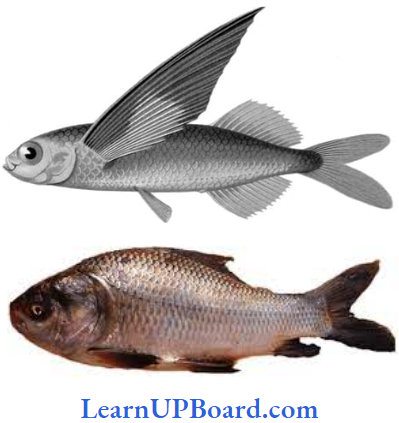
Differences Between Cartilaginous And Bony Fishes
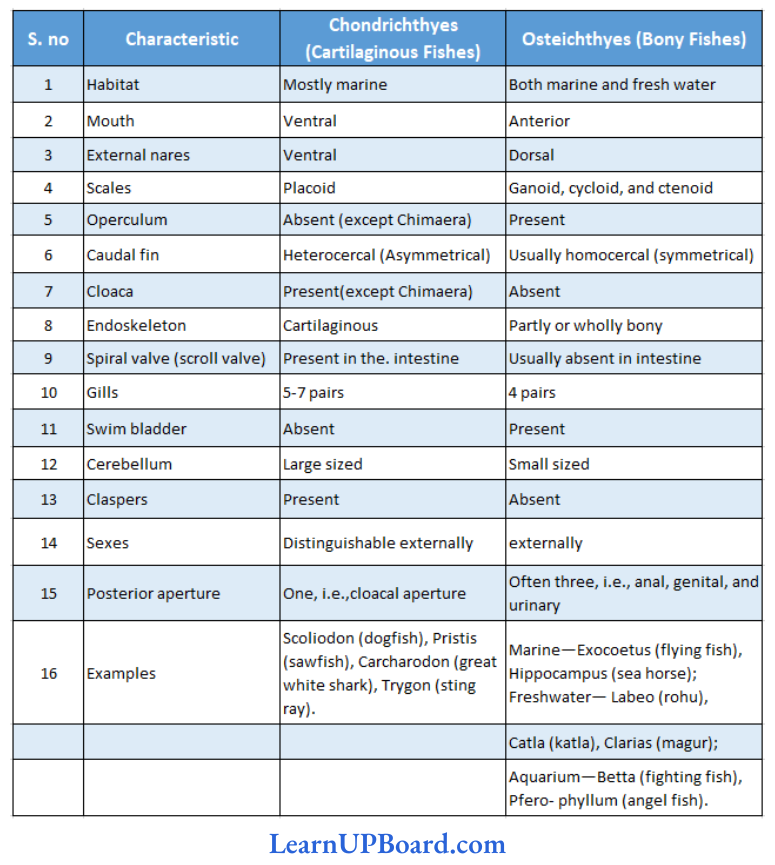
Some Important Fishes Of Super Class Pisces
Torpedo (Electric Ray): A torpedo is a bottom-dwelling, carnivorous fish. It stuns or kills the prey and enemies with electric shock from its electric organs. The latter are modified muscles. The skin is scaleless.
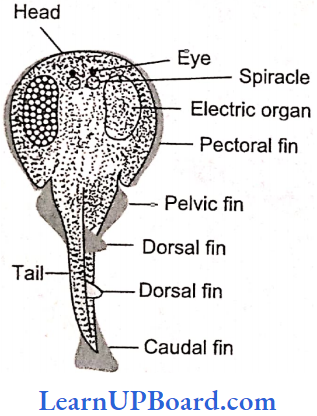
Pristis (Sawfish): The head bears a series of strong tooth-like denticles along the margin. It uses these denticles for offense and defense. It is viviparous.
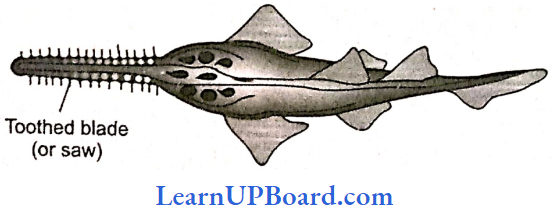
Exocoetus (Flying Fish): It does not fly but often leaps into the air up to about 6 m high. The pectoral fins are modified into wing-like structures, with the help of which the fish glides.
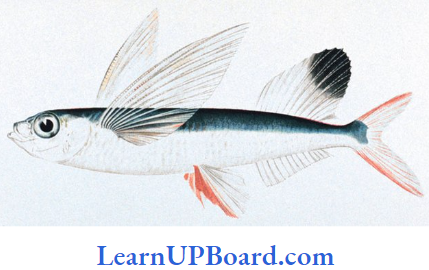
Hippocampus (Sea Horse): The neck and head of the fish are horse and the tail is prehensile. The male bears a brood pouch in which the female lays eggs and the latter remain there till they hatch.
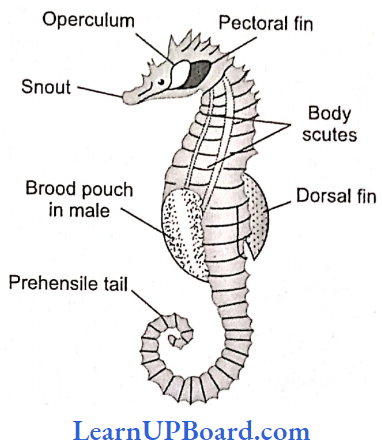
Labeo (Rohu): Labeo rohita and Labeo calbasu are the common freshwater edible carp. It is covered by large overlapping scales.
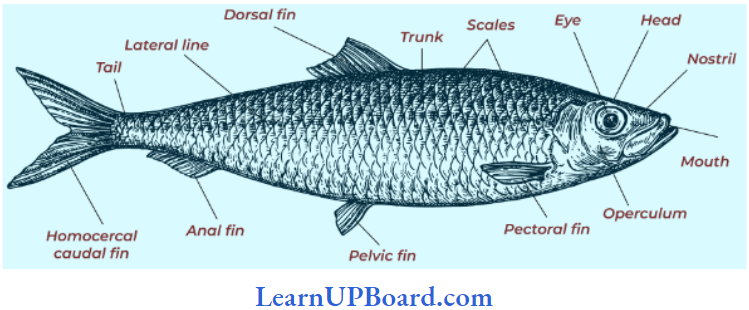
Clarias (Cat Fish/Magur): Indian catfish (Clarias batrachus) live in ponds. It is carnivorous, flic head bears sensory threads called barbels. The body is smooth and without scales. Other freshwater catfishes of India are Mystus seengala (slinghara), Rita lita, and Wallago attu (Malli).
Latimeria Chalumnae (Coelacanth): It was first caught in 1938 off the east coast of South Africa. It swims by curious rotating movements of its pectoral fins. All its fins except the anterior dorsal are lobed. It is the oldest living fish and has survived till today without undergoing any change in it. It is therefore described as a living fossil.
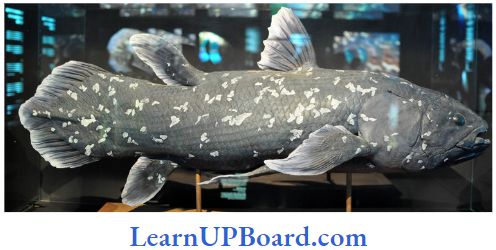
Endothermic Fishes: Although most fishes are ectothermic, a few species such as blue fish tuna, and swordfish are able to maintain a body temperature higher than the temperature of the water that surrounds them. Genetic studies of these endotherms have revealed that the ability to maintain high body temperature gives these fishes an adaptive advantage by allowing them to hunt in much colder waters than their competitors.
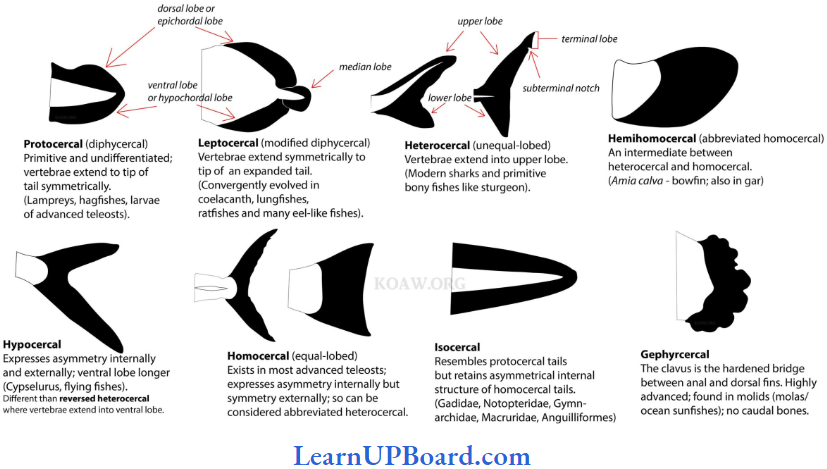
Fish taken out of water dies of suffocation due to the lack of oxygen. This is because the gill filaments stick together when taken out of water, thereby reducing the surface area.
Freshwater Species
- Labeo rohita (Rohu)
- Labeo calbasu (Calbasu)
- Catla caila (Catla/cat fish)
- Gyprinus carpio (Carp)
Marine Species
- Harpoon (Bombay duck)
- Anguilla (Eel)
- Sardinella (Salmon)
- Hilsa (Hilsa)
Some air-breathing fishes used their paired fins to move on land and gave rise to the first land vertebrates. A living fossil of this group is Latimeria, a lobe-finned fish.
Some Important Body Parts Of Super Class Pisces Fins
- Paired Pectoral And Pelvic Fins: Act as balancers and brakes; provide lift and counteract pitching and rolling.
- Anterior Dorsal Fin: Counteracts rolling and yawing.
- Posterior Dorsal And Anal Fins: Counteract yawing and rolling.
- Caudal Fin: Propels the body and provides lift.
Scales
- Cosmoid: Absent in living fishes; consists of four distinct layers: outermost ganoine, followed by cosmine, spongy bone, and innermost compact bone. For example, extinct fishes.
- Placoid: Backwardly directed spine arising from a basal plate, for example, Chondrichthyes.
- Ganoid Or Rhomboid: Scales are thick, diamond- or rhomboid-shaped plates, for example, primitive bony fishes such as Acipencer, etc.
- Cycloid: Thin, flexible, circular in outline, marked with concentric lines of growth which can be used for determining age, for example, lungfishes, Amia, etc.
- Ctenoid: Bear numerous small comb-like spines, for example, higher bony fishes such as perch, etc.
- Air Bladder: It is associated with respiration, liydrostasis, sound production, and audition.
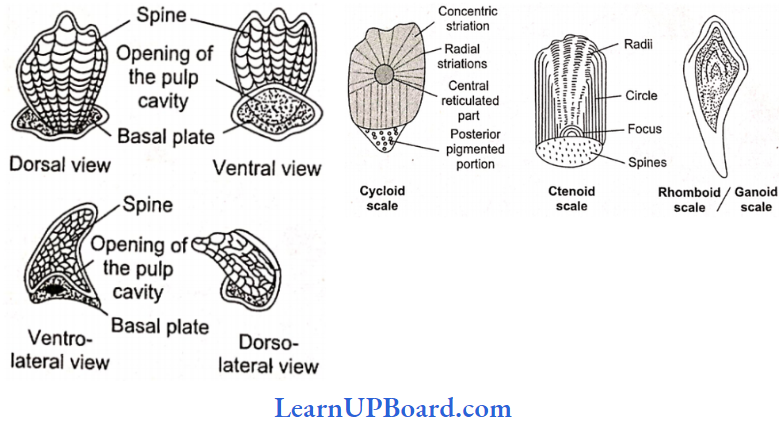
Parental Care
- Nest building, for example, Gasterosteus, Amia (bowfin), Protoptehis, and Lepidosiren (the nest is built by the males of these fishes).
- Shelter in mouth, for example, males of catfish, Arias.
- Brood pouch, for example, male Hippocampus.
Common Food Fishes Of India
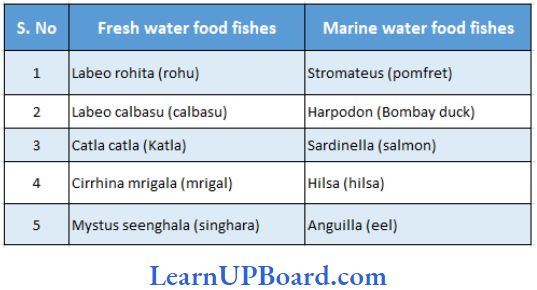
False Fishes In Animal Kingdom
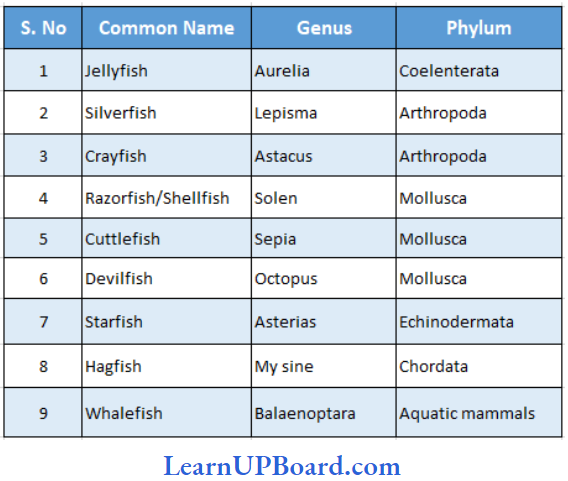
Super Class 2 Tetrapoda: All gnathostomes excluding fishes are included in this super class.
- Typically ail tetrapods (Gk. Tetra = four + podos = foot) possess two pairs of limbs.
- Skin is adapted to withstand exposure to air,
- They have lungs for aerial respiration. Their sensory organs are adapted for reception in air such as vision, hearing, smelling, etc.
- Tetrapoda is divided into four classes: Amphibia, Rep- tilia, Aves, and Mammalia.
Class Amphibia: Vertebrates with dual-life (Gk. Amphi = two or both; bios = life). The general characteristics of members of this class are as follows:
- There are about 3000 species of amphibians out of which 2600 species arc in the order Anura.
- They are present in the warmer regions of the world except for newts and salamanders, which are present in cooler regions.
- They occur only in fresh water and moist land. Amphibians are not found in seawater.
- They are poikilothermal animals. They are amphibious in nature, i.e., they can live on land as well as in water. They are mostly found in warm countries. They are ectothermic (cold-blooded). The body is divisible into a head and trunk. The tail may be present in some forms.
- The skin is smooth or rough, having cutaneous glands which keep it moist. They are usually without scales, but if scales are present, they are hidden beneath the skin (for example, Caecilians).
- Two pairs of limbs are used for locomotion.
- The gills are present at least in the larval stage; some adult forms also carry them in addition to lungs (for example, Necturns).
- The alimentary canal and urinary and reproductive tracts open into a common chamber called cloaca which opens to the exterior.
Classification of Class Amphibia
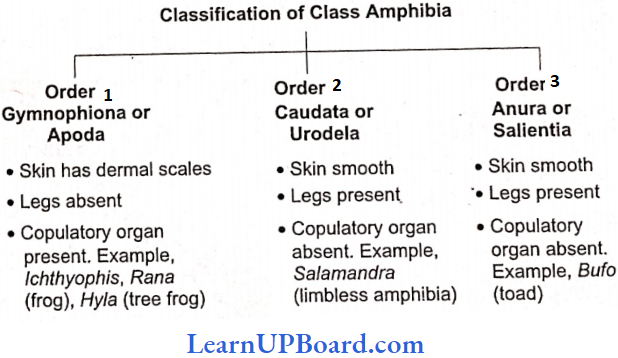
The skull is cacodylic, i.e., with two occipital condyles for articulation with the vertebral column. The respiratory organs are the lungs, buccopharyngeal cavity, skin, and gills.
- The heart is three-chambered, having two auricles and one ventricle. In the heart, there are present sinus venosus and truncus arteriosus. Both the hepatic portal and renal portal systems are well-developed.
- Kidneys are mesonephric. The urinary bladder is present in frogs. Larvae and tailed amphibians (for example, salamanders) are ammonotelic. Frogs and toads are ureotelic.
- The ear consists of the internal and middle ear. The tympanum (outer membrane) covers the middle ear. The middle ear has a single ear ossicle called columella auris.
- Ten pairs of cranial nerves are present. Sexes are separate; fertilization is external; and oviparous; and development indirect.
- They return to the water for breeding. Male lacks copulatory organs. Indirect development occurs. A fish-like stage, the tadpole, is present.
- Male frogs can croak louder than females because of the presence of vocal sacs.
- Examples: Bufo (toad), Rana (frog), Hyla (tree frog), Salamandra (salamander), Ichthyophis (limbless amphibia).
- Living amphibians are divided into three orders:
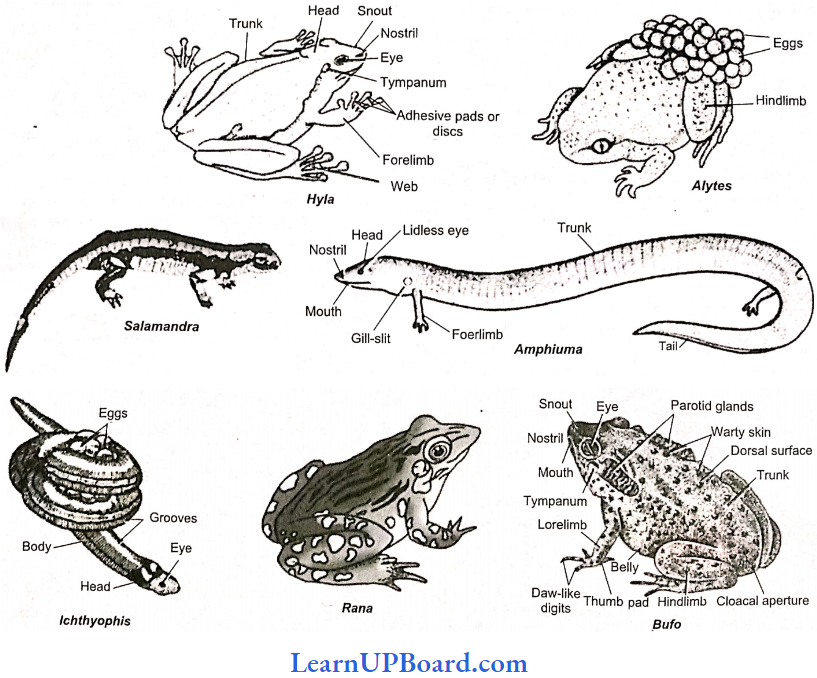
Class Reptilia: Their name refers to their creeping or crawling mode of locomotion.
- Reptiles are cold-blooded or poikilothermic animals.
- There are only about 6000 species of reptiles now living. But fossils show that 200 million years ago, the reptiles were the most dominant animals on earth.
- Herpetology is the study of reptiles.
- The largest reptiles today are the “komodo dragon” Varanus komodoensis of Indonesia (a lizard) 3 m in length, crocodiles (up to 7 m), pythons (up to 10 m), and giant tortoises weighing up to 600 kg.
- They are covered by dry and cornified skin having epi-dermal scales or scutes. Snakes and lizards shed their scales as “skin cast.” Scales prevent the loss of body water and so reptiles do not require a moist environment like amphibians.
- Respiration is only through the lungs, which is improved by the development of ribs.
- Limbs when present are in two pairs; pentadactyl; digits have horny claws.
- The mouth is terminal with conical teeth which arc pleurodont in lizards and snakes and the thecodont in crocodiles. Teeth are absent and replaced by home beaks in turtles.
- The endoskeleton is bony; the skull is monocondylic (with one occipital condyle).
- Heart is usually three-chambered or partially four-chambered. The interventricular septum is incomplete.
- The heart is completely four-chambered in crocodiles. Two systemic arches are present. Erythrocytes are oval and nucleated.
- Kidneys are metanephric. Excretion is uricotelic. The urinary bladder is absent in snakes and crocodiles.
Cranial nerves are in 12 pairs. Jacobson’s organ (vomeronasal organ) present in the roof of the buccal cavity, and concerned with smell, is well-developed in snakes and lizards. They do not have external ear openings. Tympanum represents ears.
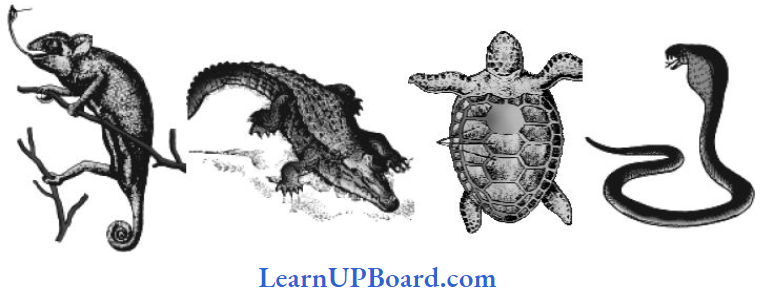
Sexes are separate. Males usually have a muscular copulatory organ. Fertilization is internal. Most are oviparous and development is direct. Some are viviparous. No metamorphosis.
Examples: Chelone (turtle), Testudo (tortoise), Chameleon (tree lizard), Calotes (garden lizard), Crocodilus (crocodile), Alligator (alligator), Iiemidactylus (wall lizard), poisonous snakes—Naja (cobra), Bangarus (krail), Vipera (viper), etc.
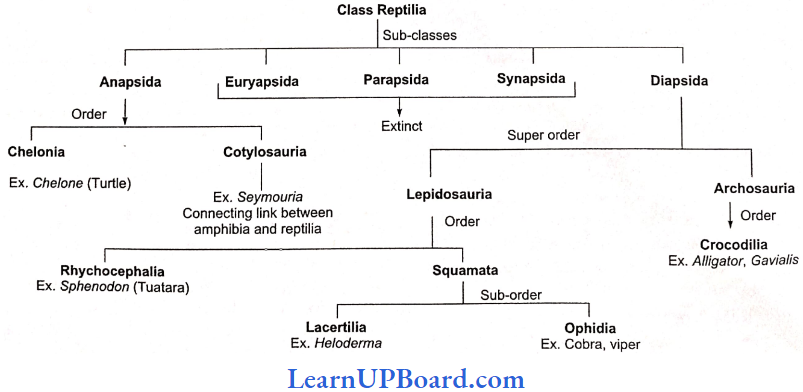
Classification Of Reptiles Is Based On The Temporal Fossa Of Skull. The Class Reptilia Is First Divided Into Five Sub Classes:
- Anapsida,
- Euryapsida,
- Parapsida,
- Synapsida, and
- Diapsida.
Out Of The Five Sub-Classes, The Living Reptiles Are Found Only In Two Sub-Classes:
- Anapsida and
- Diapsida.
- Anapsida: Primitive reptiles with a solid skull roof. No temporal openings/fossae.
- Order: Chelonia
- Commonly called turtles (marine), tortoises (terrestrial), and terrapins (edible freshwater).
- The body is encased in two shell plates, a dorsal carapace, and a ventral plastron.
- Limbs clawed, webbed, or paddle-like.
- Sternum is absent.
- Jaws with home sheath, no teeth.
- Certain aquatic turtles perform cloacal respiration, but all other reptiles respire with lungs.
- Cloacal respiration is reported.
- Order: Chelonia
- Diapsida
- Order: Rhynchocephalia
- All are extinct except a living species Sphenodon punctatum.
- Sphenodon is the “Tuatara” of New Zealand. It is a living fossil and going to become extinct.
- Sphenodon is a protected animal under the law of the New Zealand government.
- An interesting feature of Sphenodon is the presence of the pineal parietal or third eye.
- Sphenodon is referred to as a living fossil because it has retained many primitive characteristics of fossil or stem reptiles.
- Order: Squamata
- Divided into two sub-orders: Lacertilia (lizards) and Ophidia (snakes).
- Saurology is the study of lizards.
- Serpentology or ophiology is the study of snakes.
- Lizards have four well-developed pentadactyl limbs with claws. For example, Ccdotes (garden lizard).
- The tail of most lizards is easily broken off when threatened or seized by a predator. This ability is known as autotomy. Autotomy is the voluntary breaking of the tail to confuse the enemy.
- A new tail is soon regenerated which, however, does not possess vertebrae.
- Most lizards are oviparous, two viviparous lizards are Phrynosoma (homed toad) and Chameleon (tree lizard).
- Draco is a lizard that glides with the help of patagium and is hence called a flying dragon.
- Order: crocodile
- Order: Rhynchocephalia
Heloderma (Gila monster) is the only poisonous lizard in the world. It is also called a “beaded lizard” because its scales resemble beads.
There are two species of heloderms, H. suspectum, and H. horridum. Both are found in America. Heloderma rarely bites humans, but its bite is fatal. Its poison is neurotoxic.
- Limbs are absent in lizards such as Ophio-saunis, Angitis, and Rhineura, also called glass snakes.
- A limbless lizard can be distinguished from snakes by the presence of movable eyelids and external ear openings.
- Barkudia is a limbless lizard from South India.
- The glass snake Ophiosaurus derives its name from its ability to break off its tail when seized.
- Lizards are mostly omnivorous, but a herbivorous lizard is Iguana from South and Central America.
- The largest living lizard in the world is the ferocious dragon, Varanus koinodoensis, found in the Malaya Archipelago, The Length is 2.5 m, weighing over 100 kg.
Difference Between Tortoise And Turtle
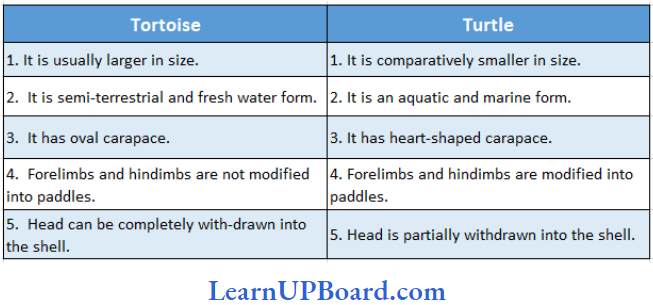
Identification Of Poisonous And Non-Poisonous Snake
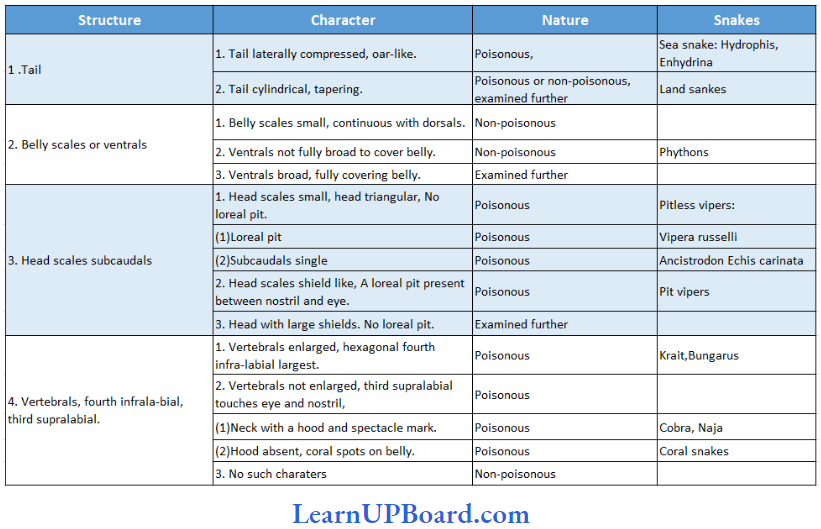
Differences Between Crocodile, Alligator, And Gavialis

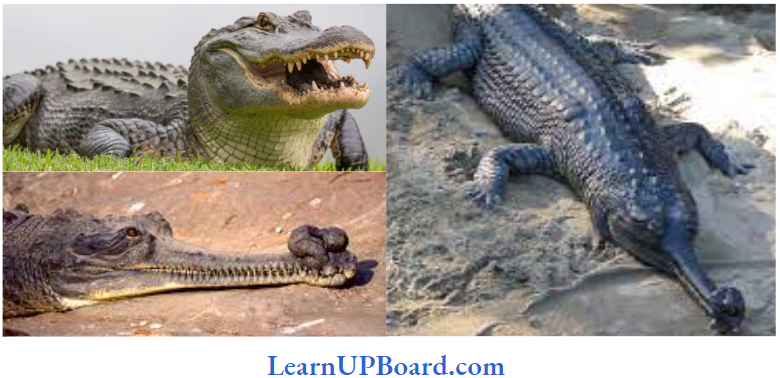
Class Axes (Birds): The study of birds is known as ornithology. The general characters are as follows:
- Birds are feathered bipeds, air-breathing, truly flying vertebrates (other being bats from class Mammalia). Jawbones are prolonged into a toothless beak or bill.
- Limbs are two pairs. Forelimbs are modified as wings for flying. Hindlimbs or legs are large, each foot usually bears four, clawed toes. Hindlimbs generally have scales.
- The exoskeleton consists of feathers, scales, and claws, which are epidermal derivatives. Skin without glands; the only cutaneous gland is the uropygial gland or preen gland/oil gland at the base of the tail.
- The esophagus is dilated into a crop for quick feeding and storage. Crop secretes “pigeon milk” during the breeding season. The stomach is divided into a glandular proventriculus and a muscular gizzard.
- The junction of the small intestine and rectum is marked by a pair of rectal cecae. The Cloaca of birds is three-chambered: anterior coprodaeu’m, middle erodium, and a large posterior proctodaeum. There is no gall bladder in birds like pigeons.
- Respiration is due to compact, spongy, non-distensible lungs continuous with thin-walled air sacs. Air sacs reduce body weight, and help in double respiration and internal cooling.
- The larynx is present without vocal cords. A sound box or syrinx-producing voice lies at or near the junction (furcula) of the trachea and bronchi.
The heart is completely four-chambered as in mammals. Sinus venosus absent. Only the right aortic (systemic) arch persists in adults. The renal portal system is vestigial. Erythrocytes are minute, oval, and nucleated.
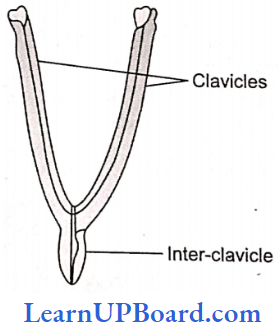
- The blood of the birds may be called the richest blood in the animal kingdom. It has more RBCs per cubic mm of blood than in any other animal.
- Kidneys are metanephric and three-lobed. Ureters open into cloaca. The urinary bladder is absent. Excretion is uricotelic.
- Cranial nerves are of 12 pairs.
- Olfactory organs are poor. The middle ear contains a single ossicle. Eyes possess a nictitating membrane. Pecten is a comb-like structure found in the eyes near the blind spot. Pecten helps in the nutrition of the eyeball. Pecten is found in all birds except Kiwi.
- Sexes separate. Some birds show sexual dimorphism (for example, parrots and peacocks). The male bird has a pair of abdominal testes and a pair of sperm ducts. A copulatory organ is absent in all birds except in ratitae, geese, ducks, etc. Females are oviparous with a single (left) functional ovary and oviduct (Mullerian duct). Development is direct.
Different Parts Of The Oviduct Secrete The Following:
- Ostium—Dense albumin
- Magnum—White albumin
- Uterus—Calcareous shell
Eggs of birds are cleidoic (with calcareous shell), macrolecithal (amount of yolk), and mesolecithal (distribution of yolk). Extraembryonic membranes are present (amniota).
- Feathers are found only in birds. Feathers are made up of the protein keratin and are waterproof due to the oily secretion of preen glands. The arrangement of feathers on the body of birds is called tylosis. The featherless areas are called as apteria. Four types of feathers are quill feathers, contour feathers, filoplumes, and down feathers.
- In the absence of down feathers, the birds will not be able to keep their body warm. Quill feathers in the wings are called remiges. Quill feathers in the tail are called rectrices. Filoplumes and down feathers help in the insulation of the body.
- Birds are the first vertebrates to have warm blood. Body temperature is regulated (homoiothermous). Ala spuria (bastard wing): Feathers on first digit (thumb).
Examples: Corpus (crow), Columba (pigeon), Psittacula (parrot), Struthio (ostrich), Pavo (peacock), Aptenodytes (penguin), Neophron (vulture).
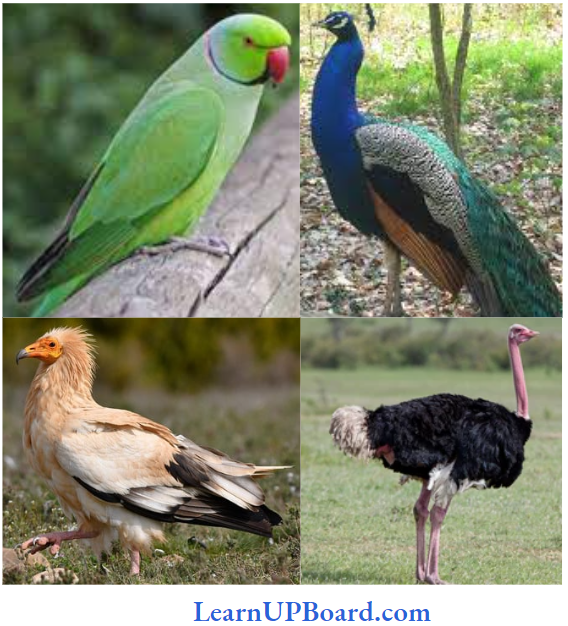
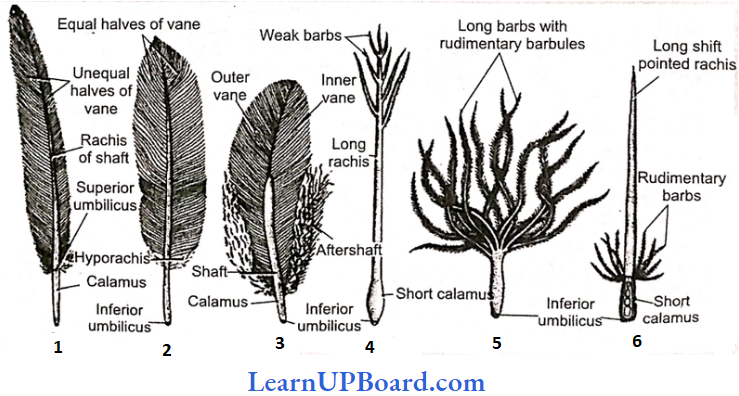
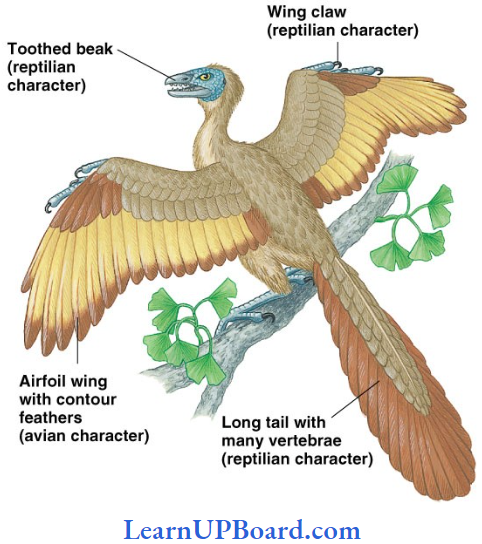
Classification Of Class Aves: Class Aves is divided into two subclasses Archaeomithes and Neomithes.
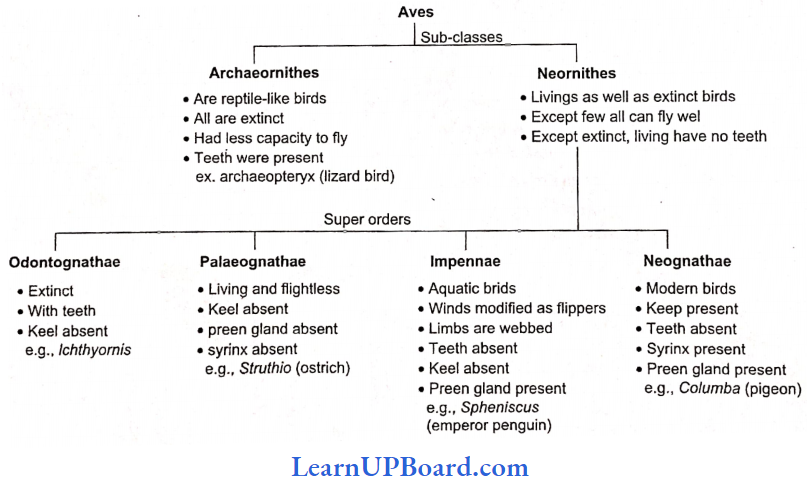
Subclass 1 Archaeomithes
- All extinct Jurassic period birds of the Mesozoic era.
- Wings primitive with little power of flight.
- Tail long, lizard-like with two lateral rows of rectrices.
- Hand with clawed fingers.
- Skull with teeth in both jaws, for example, Archaeopteryx.
Subclass 2 Neomithes
- Modem as well as extinct, post-Jurassic period birds.
- Wings are well-developed and adapted for flight (with few exceptions).
- Tail short and reduced.
- Teeth are absent except in some fossil birds.
- Sternum with keel or carina.
There are four superorders in this subclass:
- Super-order 1 Odontognathae: For example, Hesperornis (with teeth) is extinct.
- Super-order 2 Palaeognathae (Ratitae): Example, flightless running birds.
- Super-order 3 Impennae
- For example, penguins (Aptenodytes): Penguins are found in Antarctica (south pole). They have paddle-like wings and cannot fly. Penguins are marine and lay eggs in ice.
- Super-order 4 Neognathae (Carinatae): Example, modem flying birds such as Columba (pigeon), Psittacula (parrot), Neophron (vulture), and Pavo (peacock).
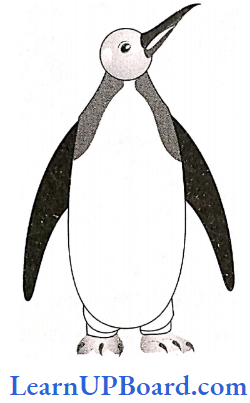
List Of Flightless Birds
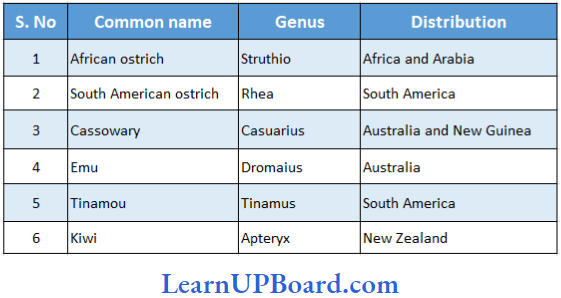
Differences Between Super Orders Ratitae And Carinatae
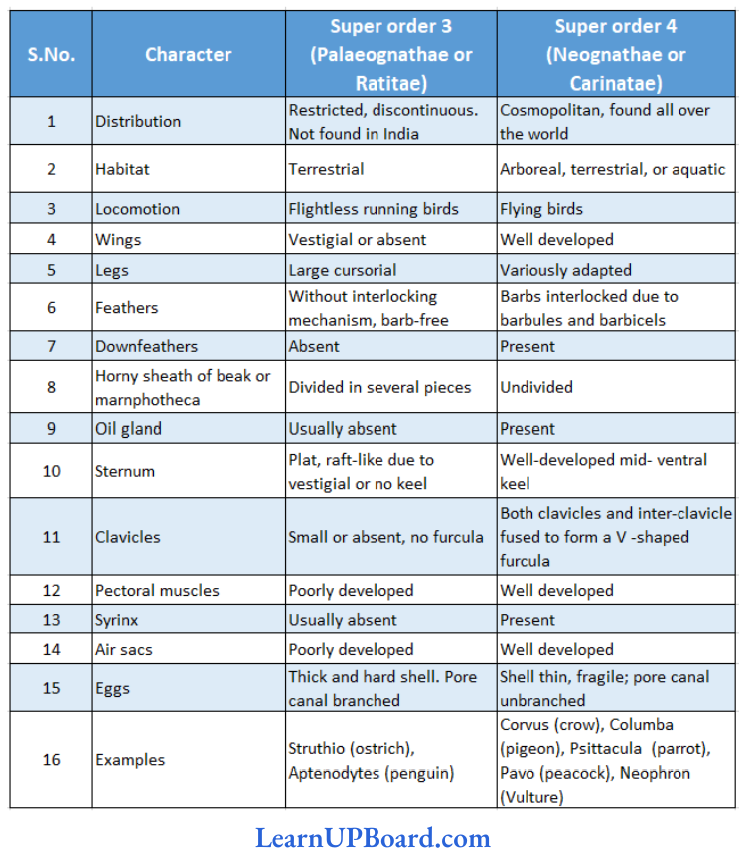
Class Mammalia: They are terrestrial, warm-blooded (endothermic), or homeothermic animals so that their body temperature remains constant in spite of the changes in the temperature of the environment. The general characteristics of this class are as follows:
- The skin is covered with epidermal hair which acts as an insulating layer and allows high body temperature to be maintained. The hair may be partly lost as a second adaptation. In some aquatic mammals where hair is negligible, there is a subcutaneous layer of heat which provides insulation of heat and makes the warmblooded condition possible.
- The skin has two kinds of glands, sudorific glands which produce sweat; evaporation of sweat controls the body temperature; second kind of glands is sebaceous glands which produce an oily secretion that makes the hair water-resistant.
- Modified sweat glands (sudoriferous) form mammary glands that produce milk in females for the nourishment of the young for some time after birth. Because they possess mammae (breasts) and mammary glands, they are called mammals. It is the most unique character of mammals.
There is an external ear or pinna with an external auditory meatus. This is in addition to the middle and internal ear.
- In higher mammals, the anus is separated from the urinogenital aperture; consequently, the urinary and genital ducts have no connection with the digestive tube.
- In males, testes have come to lie outside the body cavity in scrotal sacs (except in elephants, aquatic mammals, and prototherian mammals).
- Teeth are embedded in sockets of the jaw bone and are said to be thecodont. There are only two sets of teeth in a lifetime, one deciduous or milk set and another permanent set. This condition is spoken of as diphyodont. There are four different types of teeth, hence mammals are heterodont.
- A muscular diaphragm divides the coelom into a thoracic and an abdominal cavity; the thoracic cavity has a pericardial cavity containing the heart and two pleural cavities containing the lungs. The remaining viscera lie in the abdominal or peritoneal cavity.
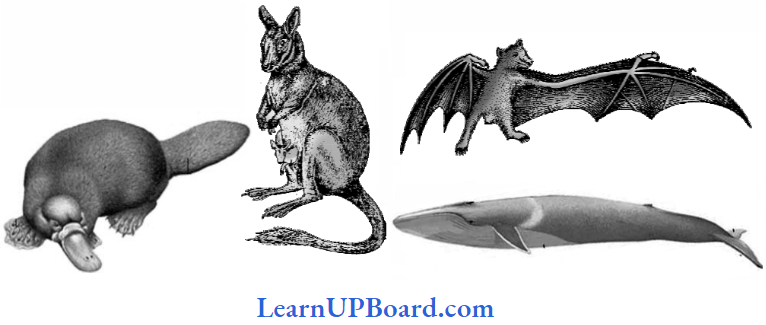
The heart is four-chambered with two auricles and two ventricles so that oxygenated blood lies in the left half and deoxygenated blood in the right half. This condition is also found in birds. Only the left aortic arch is present. Erythrocytes are round, biconcave, and non-nucleated (except in camel where they are oval and non-nucleated).
- Cerebral hemispheres and cerebellum are large-sized and highly developed with a great increase in the cortex. The two cerebral hemispheres are joined by a transverse band of nerve fibers called corpus callosum. There are four solid optic lobes called corpora quadrigeminal in the mid-brain. Twelve pairs of cranial nerves are present.
- The middle ear has three ear ossicles called malleus, incus, and stapes; the internal ear has a spirally coiled cochlea which acts as an efficient organ of hearing.
- The neck generally has seven cervical vertebrae.
- Examples: Oviparous—Ornithorhynchus (platypus); viviparous—Macropus (kangaroo), Pteropus (flying fox), Camelus (camel), Macaca (monkey), Rattus (Rat). Cains (Dog), Fells (cat), Elephas (elephant), Equus (horse), Delphinus (common dolphin), Balae- noptera (blue whale), Panthera tigris (tiger), Panthera leo (lion), etc.
Difference Between The Three Groups Of Mammals
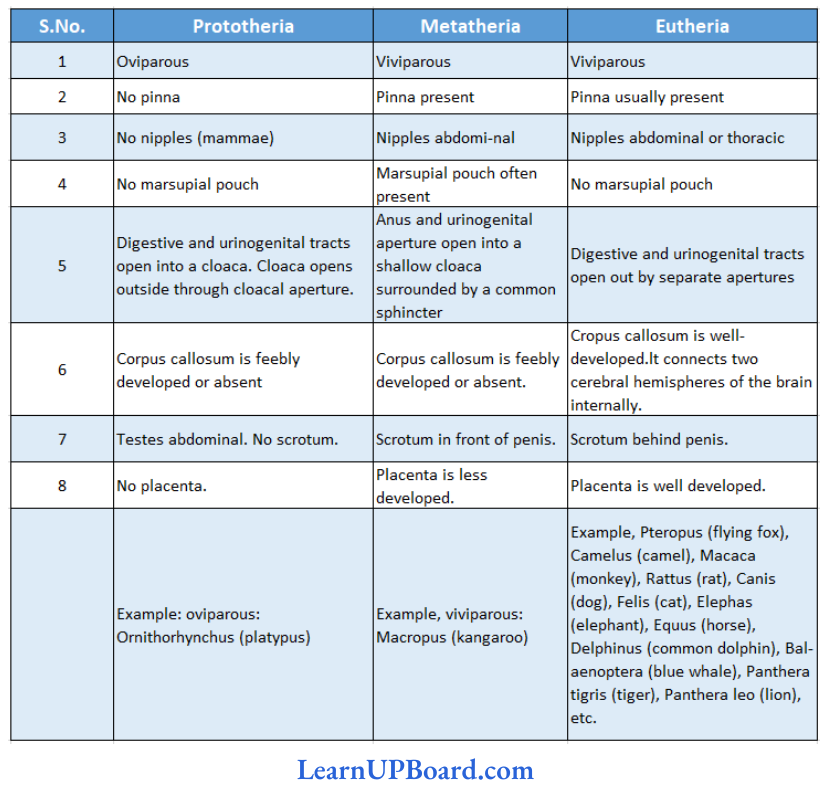
Classification Chart
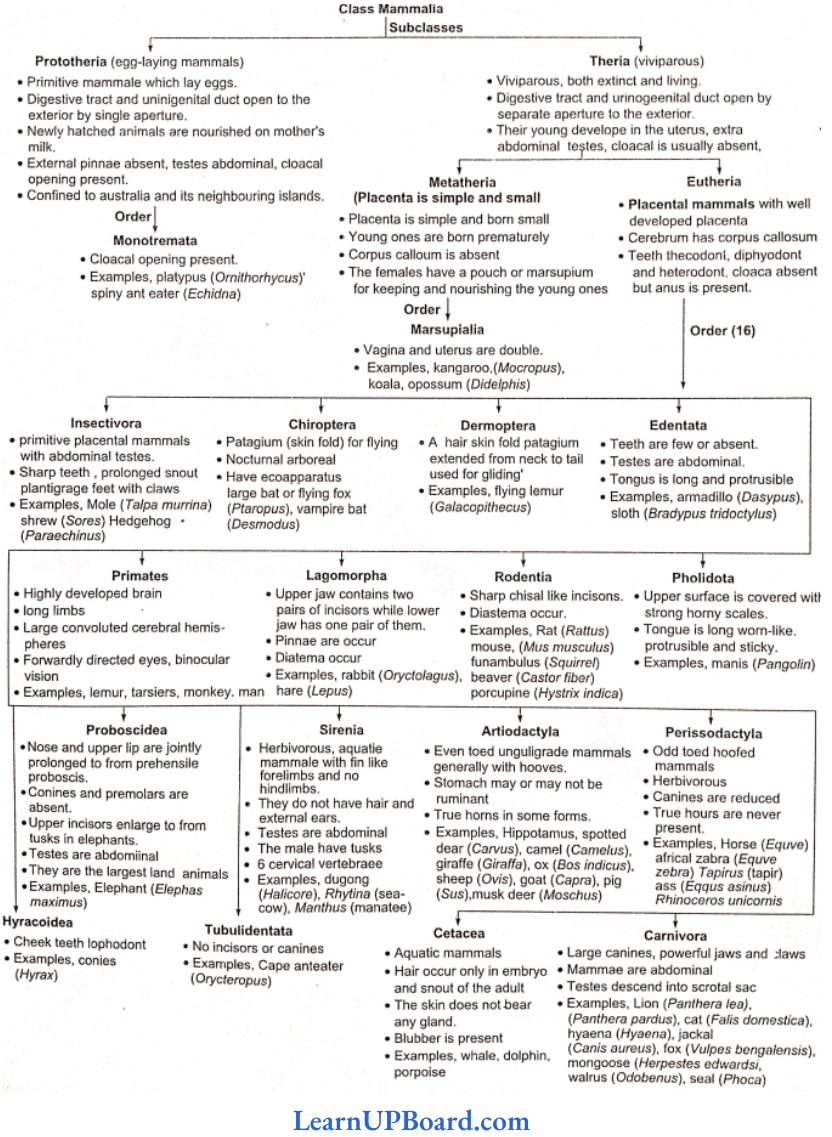
Class Mammalian Is Divided Into Three Sub-Classes: Prototheria, Metatheria, and Eutheria.
- Sub-Class 1 Profotheria Or Monotremata: They are primitive mammals that show many characteristics of their reptilian descent. Their reptilian characteristics are that they lay large yolky eggs, urogenital organs open into a cloaca and large T-shaped interclavicles.
- Their mammalian characteristics are the presence of hair and mammary glands—the latter are modified sweat glands: the presence of a diaphragm; the four-chambered heart has only the left aortic arch; and seven cervical vertebrae.
- Examples: Tachyglossus (spiny ant-eater) and Ornithorhynchus (duckbill mole), both in Australia and Tasmania.
- Sub-class 2 Metatheria Or Marsupialia: These Australian mammals are viviparous but the young are born in an immature state and develop in a pouch or marsupium on the abdomen of the mother where they are fed on milk produced by true mammary glands having teats.
- Anus and urinogenital apertures are separate but have common sphincter muscles. They have two uteri and two vaginae, in males, the scrotal sacs are in front of the penis which is often bifid.
- Examples: Macropus (kangaroo), Phascolarctos (kola bear), Didelphys (opossum), Parameles, and Dendrolagus (wallaby).
- Sub-class 3 Eutheria Or Placentalia: They have an allantoic placenta that nourishes the embryo. The placenta establishes a connection between the uterus of the mother and the developing embryo.
- They are viviparous and the young are like small adults, born after a long period of gestation. The anus and urogenital apertures are separate. The brain is highly developed and has a corpus callosum. The uteri generally and vaginae always are united into one.
Order 1 Edentate: They have no front teeth, though simple molars may be present. The snout is long and an elongated tongue is used for eating insects. Digits bear claws are used for hanging from trees.
Examples: Bradypus (sloth), and Dasypus (armadillo) (both of American origin). The sloth moves swiftly hanging upside down from trees. Yet, on the ground, it can only drag itself along at a speed of about 5 km/h. Armadillo has bony plates and shows polyembryony.
Order 2 Pholidota: Exoskeleton of epidermal scales, hair scanty, teeth absent, tongue long, sternum has rods of cartilage, limbs short with five-clawed digits.
Examples: Munis (pangolin or the scaly anteater). Pangolins use their prehensile tails while climbing from branch to branch. 1 hey arc found in the sub-Himalayan forests. Munis is also called bajra kit as it eats pebbles.
Order 3 Insectivore: Small terrestrial and nocturnal mammals living on insects and worms. Teeth are small and pointed. The brain is small and the skull is constricted in the middle.
Examples: Erinaceus (hedgehog), Talpa (mole) of the In¬dian subcontinent.
Order 4 Lagornorpha: They have sharp incisors for gnawing, and a large upper pair of incisors has a smaller pair behind it. Canines are absent. The cheek teeth bite with the lower set inside the upper.
The lower jaw has a wide range of movements due to the articular surface of the squamosal being broad and flat. Hindlimbs are long and used for jumping; the tail is short. They are herbivorous and include rabbits and hares.
Examples: Oiyctolagus (rabbit), Lepus (hare).
Order 5 Rodentia: The upper jaw has only a single pair of incisors with enamel on the anterior surface only. Hence, they become chisel-shaped by wedr and tear. The dentaries of the lower jaw are not joined and can be drawn apart. The cheek teeth bite with the upper set inside the lower. The forelimb often has a prehensile hand for holding food to the mouth. They have a very large number of species with a worldwide distribution.
Examples: Castor (beaver), Funambidus (squirrel), Mus (mouse), Rattus (rat), Hystrix (porcupine). The harvest mouse is the only European mammal to have a prehensile tail. Hystrix is the largest spiny mammal.
Order 6 Chiroptera: They are the only mammals that can fly. Forelimbs are long in which the metacarpals and phalanges of the second to fifth digits are elongated to support a fold of skin called patagium to form a wing that joins the hindlimbs and the tail.
The first digit is small, free, and clawed. Sternum has a keel for attachment of muscles of flight. Hindlimbs are weak and rotated outwards with the knees backward. They hang upside-down by their hindlimbs.
Examples: Pteropus (flying fox), Vespertilio (bat).
Order 7 Artiodactyla: They walk on the tips of their digits (unguligrade) and have an even number of dig¬its. The third and fourth digits are long and equal, end in hooves; the other digits are reduced or lost. Upper ends are absent, and lower ones bite against hardened gums.
The stomach is complicated with several chambers where bacteria digest cellulose. The frontals may grow out to form horns. They are generally large sizes and herbivorous.
Examples: Camelus (camel), Bos (cow and buffalo), Ovis (sheep), Capra (goat), Sits (pig), Giraffe (giraffe).
Order 8 Perissodactyla: They walk on the tips of their digits but have an odd number of toes. The third digit is the longest having a hoof, the other digits are generally lost or reduced.
Incisors are present in both jaws, but canines are found only in males. The stomach is simple, there is no gall bladder. They are large-sized and herbivorous; bacteria digest cellulose in a long cecum.
Examples: Equus cabalus (horse), Equus asinus (ass), Rhinoceros unicornis (one-homed Indian rhinoceros).
Order 9 Proboscides: They are an isolated group of large-sized animals with thick skin (called pachyderms) and scanty hair. They have massive pentadactyl limbs with united digits having nails. The skull has thick bones with air spaces. Testes are internal.
The nose and upper lip form a long trunk or proboscis used for transporting food and water to the mouth. Two upper incisors are elongated to form tusks of solid ivory. Canines and premolars are absent. There are three molars in each jaw, but only one is functional at a time.
Examples: Elephas maximus (Indian elephant)—tusks in males only. Loxodonta (African elephant)—tusks are present in both the sexes.
Order 10 Cetacea: Aquatic mammals breathe by lungs and have blubber or subcutaneous layer of the fat present which helps in heat conservation; skin glands absent; forelimbs are modified into paddle-like flippers; no Hindlimbs: no external ears; testes abdominal.
Balaenoptera (blue whale) is the largest animal ever lived. It is a filter feeder and feeds upon microscopic phytoplanktons. Physeter is a sperm whale with a single nostril; Delphinus (common dolphin).
Order 11 Sirenia: Herbivorous aquatic mammals, blubber present, intra-abdominal testes. They have homodont teeth and tusks.
Examples: Halicore, Manatee (sea cow).
Order 12 Carnivore: Canines and carnassials are well developed. The last upper premolar and the first lower molar are modified as shearing teeth or carnassials for cutting the bone and flesh, for example, Panthera tigris (tiger). Acinonyx jubatus (cheetah), Can is (dog), Eel is (cat), Panthera leo (Lion).
Order 13 Primates: Primates include loris, lemurs, tarsiers, Macaca (monkeys), apes, and man. They have plantigrade locomotion. Large, convoluted cerebral hemispheres are present.
Salient Features Of Different Phyla In The Animal Kingdom
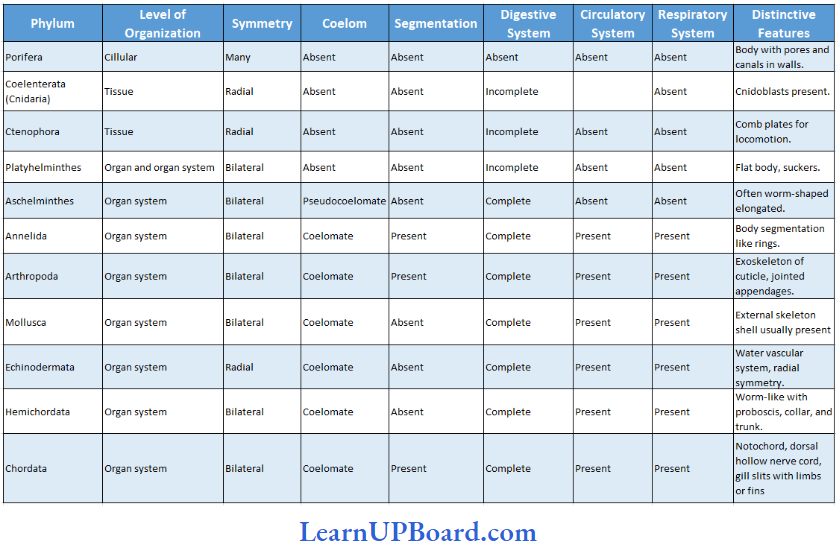
Animal Phyla With Example
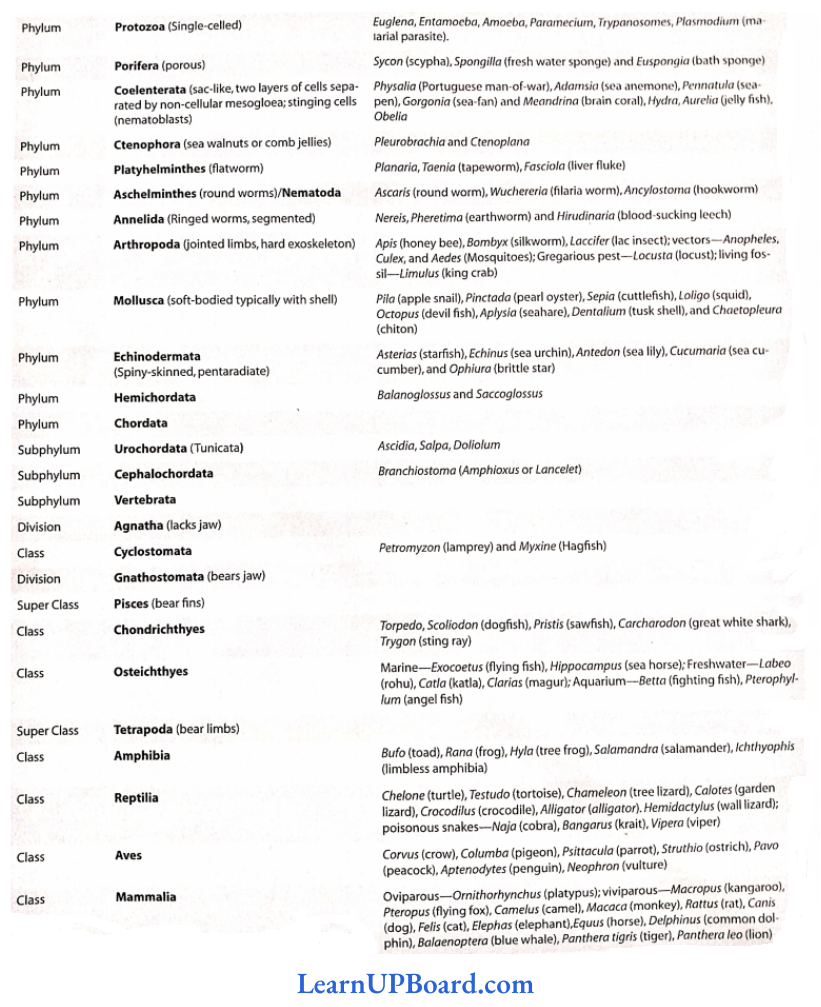
Comparison Among The Various Classes Of Vertebrata
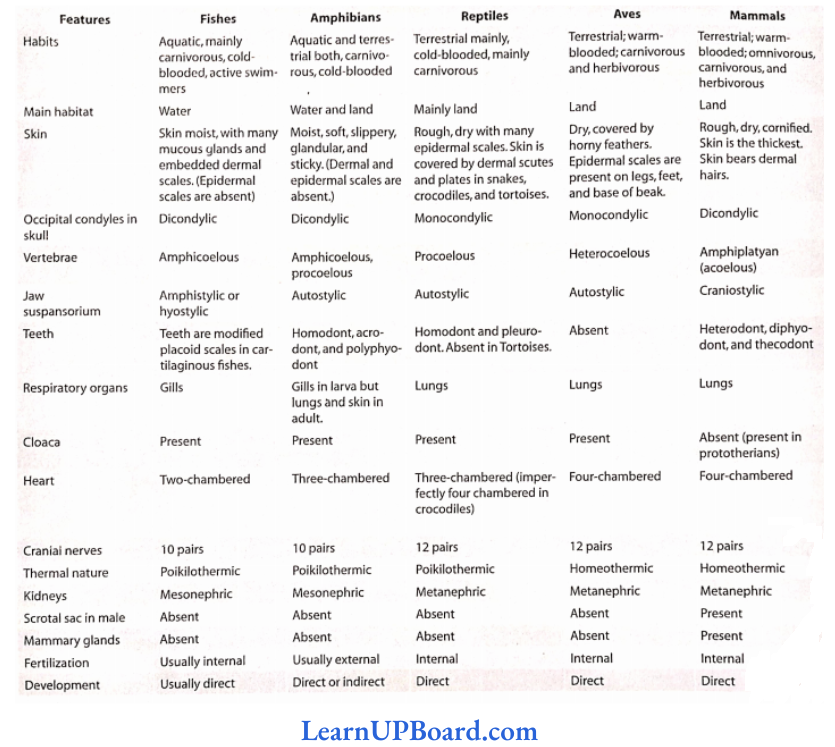
NEET Biology Notes Animal Kingdom Phylum Chordata Points To Remember
Stonefish is the most poisonous fish. Gambusia fish (larvivorous) was introduced into several tropical regions to control malaria.
Catadromous fishes live in fresh water and go down to sea for breeding, for example, Anguilla (European Anadromous fishes live in seawater and move to rivers for breeding, for example, Hilsa, Salmon, etc. When fishes migrate from sea to rivers, it is called anadromous migration.
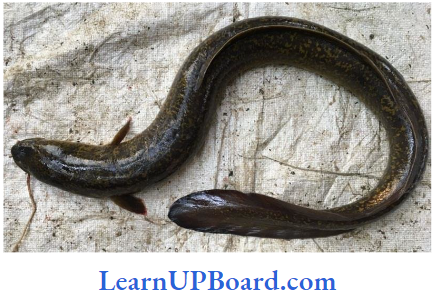
- Hilsa is the only Indian fish that migrates from sea to rivers for breeding.
- The most primitive fish (fossil) is Climatius (placodermi).
- Anabas (climbing perch). It has accessory respiratory organs for breathing atmospheric air which enables the fish to take long overland excursions in search of earthworms.
- Pomfret is the most widely eaten fish in India.
- Dipnoi has an incompletely divided three-chambered heart.
- The urinary bladder is absent in fish.
- Some elasmobranchs retain urea in the blood to maintain hypertonicity.
- Ampulla of Lorenzini is a thermoreceptor.
- Electric organs of electric ray are modified muscles.
- Bioluminescent fishes: Anamalops, Porichthycs, etc.; sound-producing fishes: Molct, Batistes.
- Poisonous glands are found in sting ray, eagle ray, Chimaera, Diodon, and Tetrodon.
- Fish byproducts are fish meals and fertilizers; fish flour, fish proteins, fish oil, steaming, fish glue, leather, artificial pearls, etc.
- Weberian ossicles were discovered by Waber (1820). These connect the air bladder with the internal ear.
- The commercial name of the integument of Scoliodon is “shagreen.”
- Typical trunk vertebrae of fish are amphicoclous, centrum peculiar as is supported by four wedge-shaped calcified fibrocartilages forming a “Maltese cross” and leaving an uncalcified area.
- The study of fish is called ichthyology.
- The study of skates, rays, and sharks is called torpedology.
- Crossopterygians (Rhipidistia, Osteolepis genus) gave rise to amphibia.
- Parental care is well-developed in the Hippocampus.
- Isinglass is a gelatinous product obtained from the air bladders of certain fishes such as carp, salmons, catfishes, etc. It is used for making cements, and jellies, and for clarification of wines and beers.
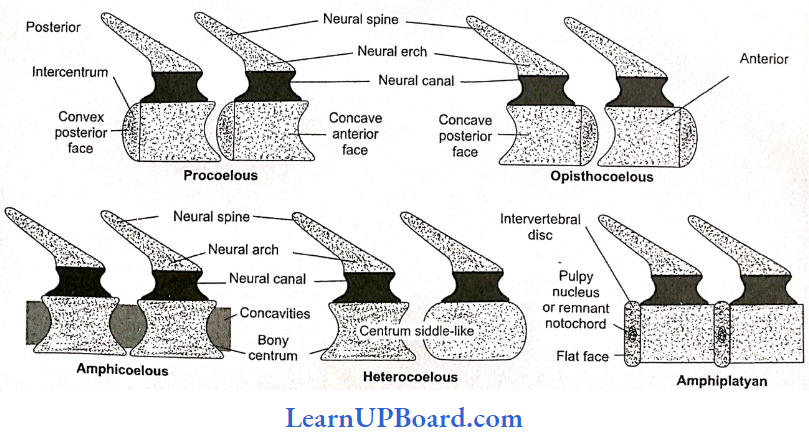
Types of vertebrae
- Petromyzon, though marine, goes to fresh water for spawning, i.e., anadromous. After spawning within a few days, they die.
- Larva ammocoete hatches out of eggs in about 14-21 days. The larval period may long from three to seven years.
- Ammocoete is the connecting link between Amphioxus and the cyclostomes.
- Lingual cartilage is also a part of the skeleton, that lies in the tongue region and supports it (lingual = related to the tongue).
- Typhlosole is a fold of epithelium in the intestine. It prevents the rapid flow of food in the intestine and increases the absorptive surface area.
Types Of Caudal Fin
- Diphycercal Or Protocercal: The most primitive kind of tail fin. The tail is symmetrical, both externally and internally as in protocercal, but it is secondarily symmetrical.
- Heterocercal/Hypocercal Tail: Epicaudal and hypocaudal lobes are of unequal sizes.
- Homocercal: Identical lobes. Externally symmetrical and internally asymmetrical.
Some frogs have developed in amazing ways to prevent their eggs from drying out. The female Surinam toad of South America carries her eggs in the pits/pockets of skin on her back. As many as 60 young ones pass through the tadpole stage while embedded in her back and then emerge as small frogs.
In frogs, external ears are absent, only the tympanum is seen externally. Frogs have a tympanic membrane on the surface of both sides of their head. The tympanic membrane of a human is called the eardrums and each is protected inside the ear canal.
Word Roots And Origins
- Caudata: From Latin, Caudata meaning “tail.”
- Nictitating: From Latin, nictare meaning to “wink.”
Seymouria is a connecting link between amphibia and reptiles.
Paedogenesis: Development of gonads and/or production of young ones by immature or larval forms, for example, salamander (Ambyostoma).
- Total neoteny is shown by Necturus, Siren, and Proteus.
- Toads are used in Chinese medicines. The skin of the toad secretes a substance that increases blood pressure when injected into humans.
- The skin of a tadpole also secretes an enzyme, diastase.
- The upper jaw of a frog is derived from quadrate cartilage whereas the lower jaw is derived from Meckel’s cartilage.
- The first toe is called hallux.
- Jaw suspension is autostylic; urostyle is the last component of the vertebral column.
- The shape of the second to seventh vertebrae is procoelous (typical); the eighth vertebra: is amphicoelous; the ninth vertebra: is acoelous.
- Amphiinna has the largest RBCs among vertebrates.
- At the time of metamorphosis, tadpoles do not feed.
- Blind worms (limbless amphibians) are unusual amphibians as only one species lives in water. All the others burrow underground and are rarely seen on the surface. Many do not even need water to breed. The carboniferous period is known as the age of amphibians.
- The arrow poison frogs secrete a powerful poison from the skin which can cause instant death.
- The most poisonous frog—The golden dart poison frog—is from South America. One adult frog contains enough poison to kill 200 people.
Types Of Feathers
- Quills: They are large feathers found in wings and tails.
- It has a central axis called the shaft.
- The small proximal part of the shaft is hollow; translucent, and cylindrical and is termed as calamus. The longdistal, solid, and opaque part of the stem is known as rachis.
- An umbilical groove extends all along the ventral side of the rachis.
- A small hole on the proximal end of the calamus is known as the inferior umbilicus; the hole on the distal end of the calamus is known as the superior umbilicus.
- Each vane is composed of parallel filaments, the barbs. Each bears barbules.
- The distal barbules of each barb bear small hooklets.
- Emu birds have an after shaft as long as the main shaft.
- Coverts: They are small feathers found in the wings and tail. They fill up the gaps left between the bases of the quills. They have short calamus in comparison to quills.
- Contours: Small feathers that cover the body and give it its shape. They resemble the quills, but their barbs are not so strongly joined and can be separated easily.
- Filopluntes: Occur beneath contour feathers; very small in size; consist of long rachis bearing at the tip a few weak free barbs with barbules.
- Down Feathers/Nestling Downs: They cover the newly hatched bird. They consist of a short calamus, and reduced rachis bearing flexible barbs with short barbules. They are found beneath contours.
- Bristles: Short calamus, a long rachis bearing a few vestigial barbs at its base. Bristles occur near the mouth in flycatchers. The first digit of the hand (thumb or pollex) bears a tuft of small feathers known as a bastard wing or ala spuria or false wing.
- Benadryl is used as an antidote to counteract the effect of hemotoxin.
- Seymouria is considered as the connecting link between amphibians and reptiles.
- The Mesozoic era is known as the “age of reptiles.”
- The loreal pit of a viper is a thermoreceptor organ.
- Reptiles without urinary bladder are snakes, crocodiles, and alligators.
- Many sea snakes are viviparous. Pit vipers are also mostly viviparous.
- The oldest living animal in any Indian zoo is the Aldabra giant tortoise.
- Rattle snake’s tail emits a frightening sound that scares away the enemy.
- The king cobra of India is the only snake in the world that builds a nest.
- The largest snake is a python; the smallest snake is a thread snake.
- The largest lizard is the Komodo dragon; the smallest lizard is two species of dwarf gecko
The longest dinosaur is Dipldocus; the smallest dinosaur is Compsognathus.
- The heaviest dinosaur is Brontosaurus.
- Largest living reptiles are (1) python, (2) crocodile, and (3) Komodo dragon.
- Hemidactylus or wall lizard (gecko) is a swift runner on smooth vertical surfaces due to the presence of vacuum pads.
- Draco is a flying lizard but it does not fly.
- Heloderma is a poisonous lizard (Gila monster).
- Ophiosaurus is known as “glass snake,” “blind worm,” or “slow worm,” limbless lizard.
Anguis is also known as a blind worm and is limbless. The most poisonous snake in the world is the peninsular tiger snake.
Poisonous Sea Snake: Hydrophis
- Biggest flesh eater dinosaur is Tyrannosaurus
- Homed Dinosaur: Stegosaurus
- The monitor lizard (Varanus) is the largest living lizard. Varanus is commonly called “Goye” or “monitor”; semiaquatic; slightly laterally compressed tail.
- A carapace is a hard shield-like structure present on the dorsal surface of a tortoise or turtle.
- Reptiles arose in the lower carboniferous time, from labyrinthodont amphibia.
- Phrynosoma is found in deserts; called “homed toad,” skin hygroscopic; takes water in the form of dew; exudes red blood-like stream from eyes, whenever, terrified.
Iguana is 5-6 feet long; body and tail laterally compressed; arboreal in habit; herbivorous found in tropical America.
- Sphenodon is the only living genus of Rhynchoce- phalia. It is commonly called Tuatara. It is found only in New Zealand. It is called a living fossil as it resembles with Hanaesaurus of the Jurassic age.
- The largest living carnivorous reptile is the Crocodihts.
- Thermomorpha is a group of reptiles that are considered to be the ancestors of mammals.
- Hedonic glands present in males secrete a sticky substance that hardens structures such as the spine and helps to hold the mate firmly.
- In Uromastyx, the cloaca possesses a pair of copulatory organs called hemipenes.
- Russel’s viper is the largest Indian viper.
- Hafkine Institute of Bombay is the main center where antivenom is produced.
- The limbs of the Chameleon show syndactyly (fusion of digits) as an adaptation to arboreal life to form opposable fingers to hold the twigs.
How many vertebrae do giraffes have in their neck? Most of the vertebrates, including giraffes and camel, have seven cervical (neck) vertebrae. At almost 6 m (20 ft) tall, the giraffe is the tallest of all vertebrates and its seven cervical vertebrae are greatly elongated. Exception: three-toed sloth (Bradypus) with nine cervical vertebrae and Manatee with six neck vertebrae.
Armadillos: The nine-banded armadillo (Dasypus) is one of the few mammalian species whose range is expanding. In the late 1800s, they lived only as far north as central Texas. Leprosy bacteria is cultured in the armadillos (Dasypus).
- Humans remain plantigrade at rest or during locomotion; use only their toes for running. Thus, is called sub-plantigrade.
- The color of human skin is yellow to orange due to carotene pigment in the cells of the stratum corneum and subdermal fat cells. Melanin is found in melanocytes.
- In humans, sweat glands are absent at lip borders, clitoris, glans penis, and nail beds, under the surface of the prepuce.
- Sweat or sudoriferous glands secrete sweat. Sweat comprises 95% water and 5% metabolic waste.
- Spiny anteaters, scaly ant eaters, moles, cetaceans, sirenians, and some edentates do not possess sweat glands.
- Tusks of elephants are two incisors of the upper jaw that constantly grow throughout life.
- Primates such as monkeys, man, apes, etc., acquired three-dimensional vision clues to their most evolved motor understanding of visual sensation.
- Deer, amongst vertebrates, proportionately to their body size, possess the largest eyes.
Carnassial Teeth: Special shearing teeth in carnivores for cracking bones—fourth premolar of the upper jaw and first molar of the lower jaw.
Milk-Producing Male Mammal: Spiny ant eater/ Echidna.
Monotreme: With a single aperture of cloaca for urinogenital and digestive tracts.
Largest Land Animal: Loxodonta africana (African elephant), height 3.5 m and weight 7 tonnes.
Tallest Land animal/mammal: Giraffe, up to 6 m.
- Mouse and Rat have first molar bigger than combined second and third molars.
- Stripes of no two zebras are alike.
Fastest Mammal: Acinonyxjubatus (Cheetah) (extinct from India but present in Africa). Speed up to 100 km/h.
Slowest Terrestrial Mammal: Three-toed sloth (Bradypus), Tridactylus, 100-150 m/h.
Slowest Aquatic Mammal: Sea otter, 10 km/h.
Longest Gestation Period In Mammal: 609 days/20 months in E/epbas maximus.
Shortest Gestation Period In Mammal: Opossum, 12- 13 days.
- Panthera tigris is the national animal of India (declared in 1973).
- Today marsupials are found mainly in Australia except a few marsupials such as the American opossum are found outside that continent.
- Plantigrade mammals are those whose palms and soles touch the ground when moving from one place to another, for example, bears and certain insectivores.
- Rabbit is a digitigrade because it moves on digits.
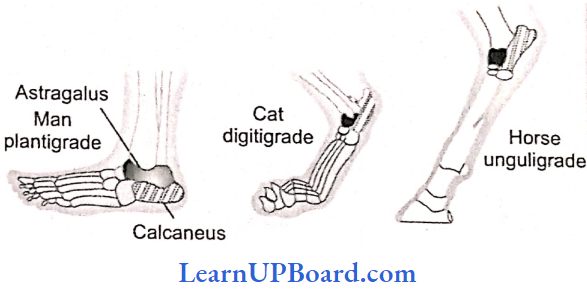
Unguligrade mammals are those whose only the tips of one or two fingers and toes remain in contact with the ground both at rest and locomotion. These are fastest fastest-running terrestrial mammals, for example, horses, deer, cows, donkeys, etc.
- Hides are prepared from the dermis of animal skin.
- Seals and whales have scanty hairs because heat insulation is done by blubber.
- The horns of rhinoceros, scales of scaly anteaters, and spines of porcupines are derivatives of hairs.
- The retina of owls contains only rods (suitable for nocturnal habit). Also, the same occurs in shrews, hedgehogs, rodents, bats, etc.
- The retina of fowls contains only cones (suitable for diurnal habit). Squirrels also have only cones.
- Whales, mice, shrews, and also some other mammals, but not rabbits and man, possess a Harderian gland like that of a frog.
The scrotum of mammals contains testes in most of the mammals; it acts as a thermostatic chamber. Testes lie outside the abdominal cavity because sperm cannot develop in body temperature.
- Thus, these become close, if the temperature falls more than 2°C or comes apart from the body if the temperature rises more than 2°C of the body temperature.
- In insectivores, Chiroptera, and Rodentia, the scrotum is formed only during breeding season. It later moves to the abdominal cavity, for example, bat, or otter.
- Insectivores. edentates, proboscidians (elephants), and cetaceans (whales) always have their testes inside the body cavity.
Brood Parasite: Male Eudynamys (koel, kokila) sounds like kuoo-kuoo-kuoo. The female is generally heard during the breeding season and has a short and sharp call kik-kik-kik, otherwise, she is mostly silent. It does not make any nest but lays eggs in a crow’s nest. In this way, koel is a nest parasite. The male is black. The female is brown and profusely spotted. The white Koel is known as the Indian nightingale because of its pleasant sound.
Eagle Eyes: Eagles have much better vision than humans do. The bird’s keen eyesight allows it to see prey at great distances. Its visual acuity is three to four times higher than that of humans.
Snake Charming
- Contrary to general belief, the snake charmer’s cobra does not dance the tune of the flute.
- Rather it follows the movement of the tip of the flute and the swaying body of its master, who really moves with the rhythm of the music.
- Raising its head and spreading its hood, the cobra gets ready to strike the moving flute tip.
- The charmer knows the striking distance and adjusts himself so that the snake orients towards the waving flute but keeps beyond the strike distance.
Rattle Snake Muscles
- Rattlesnakes have the quickest moving skeletal mus¬cles in the animal world.
- Their tail muscle allows them to shake their rattle 90 times each second.
- Most muscles would quickly tire from this kind of energetic activity, but the rattlesnake can shake its tail for long periods of time.
- The muscle’s ability to use ATP in an efficient manner allows it to sustain a high level of activity.
Largest Bird: Struthio camelus—8 feet height, 300 lbs weight.
Smallest Bird: Mellisuga helenae—5.5 cm long.
Smallest Egg Of The Bird: Mellisuga (hummingbird). The hummingbird is the only bird that can fly backward as well as forward.
Largest Egg Of Bird: Struthio—1.5-L capacity.
Largest Sea-Bird: Diomedea epomorphora (royal albatross); wing stretch 200-375 cm.
Deepest Diver Bird: Aptenodytes toaster (emperor penguin)
Fastest Swimmer Bird: Pygoscelis papua (penguin)
Fastest Runner Bird: Stnithio—60 km/h speed.
The Heaviest Bird of prey is the vulture griffin.
Fastest Flying Bird: Swift—rarely touches the earth.
- The second largest bird is the emu (Dromaeus) as is the most primitive living bird.
- The recently extinct bird is the Dodo (passenger bird) of Mauritius.
- The incubation period of a hen’s egg at 102°F (38.8°C) is 21 days.
- Though polygamy is common in birds, emu is strictly monogamous.
- Penguins are flightless birds found in Antarctica; wings are paddle-like; act as flippers during swimming; and are covered by scale-like feathers.
T.H. Huxley said, “Birds are glorified reptiles.” The feathers are highly modified reptilian scales. Birds have scales on their legs. Their eggs resemble reptilian eggs in general but have a calcareous shell.
- Among the Indian birds, the sunbirds are probably the smallest.
- The bursa fabricii is a blind sac with much lymphoid tissue in the cloaca of some young birds. It produces lymphocytes (a type of white blood corpuscles). It is also called “cloacal thymus.”
- Columbia has the world’s richest diversity of birds.
Uropygium (tail): The projecting terminal portion of a bird’s body from which the tail feathers arise.
Swifts use saliva for binding nest materials.
- Kiwi lays the largest egg in proportion to its own size.
- The Himalayan bearded vulture is the largest Indian bird. Previously, the Sams was considered the largest Indian bird.
- Ostriches have the largest eyes of any land animal.
- Kiwi is the only bird known to use the sense of smell to find food on the ground.
- Indonesia has the most bird species facing extinction.
- Red-billed Quelea {Ouelea quelea) of Africa are the most abundant birds. Previously, the house sparrow was considered the most abundant species of birds.
- Jatinga is a village in Assam where a mass suicide of birds occurs.
- The owl rotates its head through an angle of 270° as its eyes do not rotate in their sockets. Each eye is fixed like a car headlight.
- The copulatory organ (true penis) is present in ostrich, duck, swan, and geese.
- Dr Salim Ali is a famous Indian ornithologist.
- The national bird of India is Pavo cristatus (peacock).
NEET Biology Notes Animal Kingdom Assertion Reasoning Questions And Answers
In the following questions, an Assertion (A) is followed by a corresponding Reason (R). Mark the correct answer.
- If both Assertion and Reason are true and the Reason is the correct explanation of the Assertion.
- If both Assertion and Reason are true, but the Reason is not the correct explanation of the Assertion.
- If Assertion is true, but Reason is false.
- If both Assertion and Reason are false.
Question 1.
Assertion: The mantle of pearl oyster is three-layered.
Reason: Nacresecreting cells are present just below the nacreous layer.
Answer: 2. If both Assertion and Reason are true, but the Reason is not the correct explanation of the Assertion.
Question 2.
Assertion: Annelids, arthropods, and mollusks are protostome coelomates.
Reason: All three phyla include members with bilateral symmetry and true coelom.
Answer: 2. If both Assertion and Reason are true, but the Reason is not the correct explanation of the Assertion.
Question 3.
Assertion: The honey bee queen copulates only once in her lifetime.
Reason: The honey bee queen can lay fertilized as well as unfertilized eggs.
Answer: 2. If both Assertion and Reason are true, but the Reason is not the correct explanation of the Assertion.
Question 4.
Assertion: The Spongocoel of the sponges is also called the paragastric cavity.
Reason: Trophocytes are present in the spongocoel and release digestive enzymes outside, causing the digestion of food in spongocoel.
Answer: 3. If Assertion is true, but Reason is false.
Question 5.
Assertion: Ancylostoma duodenale is odd world hook worm.
Reason: Humans are infected when filariform larvae in the moist soil penetrate the skin, usually feet or legs.
Answer: 2. If both Assertion and Reason are true, but the Reason is not the correct explanation of the Assertion.
Question 6.
Assertion: Taenia solium is a cestode acquired by eating undercooked pork.
Reason: Adult Taenia causes cysticercosis in humans.
Answer: 3. If Assertion is true, but Reason is false.
- If both Assertion and Reason are true and the Reason is the correct explanation of the Assertion.
- If both Assertion and Reason are true, but the Reason is not the correct explanation of the Assertion.
- If Assertion is true, but Reason is false.
- If both Assertion and Reason are false.
Question 7.
Assertion: In Balanoglossus, proboscis is involved in excretion.
Reason: Glomerulus is present in proboscis.
Answer: 1. If both Assertion and Reason are true and the Reason is the correct explanation of the Assertion.
Question 8.
Assertion: Birds have a metanephric kidney and no urinary bladder.
Reason: South American ostrich has a urinary bladder.
Answer: 2. If both Assertion and Reason are true, but the Reason is not the correct explanation of the Assertion.
Question 9.
Assertion: All birds, except the one like Koel (Cuckoo) build nests for retiring and taking rest during night time.
Reason: Koel lays eggs in the nests of tailor birds.
Answer: 3. If Assertion is true, but Reason is false.
Question 10.
Assertion: The duckbilled Platypus and the spiny ant-eater, both are egglaying animals yet are grouped under mammals.
Reason: Both of them have seven cervical vertebrae and mammary glands without teats.
Answer: 1. If both Assertion and Reason are true and the Reason is the correct explanation of the Assertion.
Question 11.
Assertion: Amphibians have evolved from fishes.
Reason: Take the example of the fossil Archaeopteryx.
Answer: 3. If Assertion is true, but Reason is false.
Question 12.
Assertion: Snakes exposed to gamma rays become non-poisonous.
Reason: Poisonous snakes have poison glands and a pair of poison fangs. They are affected by gamma rays.
Answer: 1. If both Assertion and Reason are true and the Reason is the correct explanation of the Assertion.
Question 13.
Assertion: Among the land animals, Cheetahs can run fastest over the ground.
Reason: Cheetah uses its powerful forelimbs to push itself forward during running.
Answer: 1. If both Assertion and Reason are true and the Reason is the correct explanation of the Assertion.
Question 14.
Assertion: Salamanders and Sphenodon are classified as amphibians.
Reason: Their skin is naked, moist, and glandular.
Answer: 4. If both Assertion and Reason are false.
Question 15.
Assertion: The lateral line system is found in fishes and aquatic larval amphibians.
Reason: The lateral line system has receptors which are the clusters of sensory cells derived from the ectoderm.
Answer: 2. If both Assertion and Reason are true, but the Reason is not the correct explanation of the Assertion.
Question 16.
Assertion: A bony fish can stay at a particular depth without expending energy in swimming contrary to the cartilaginous fishes.
Reason: In bony fishes, the swim bladder is present which helps in buoyancy.
Answer: 1. If both Assertion and Reason are true and the Reason is the correct explanation of the Assertion.
Question 17.
Assertion: Lycaenops is a mammal-like reptile.
Reason: Mammal-like reptiles originated in the Permian period.
Answer: 1. If both Assertion and Reason are true and the Reason is the correct explanation of the Assertion.
Question 18.
Assertion: Reptiles can be termed as first true land animals.
Reason: These are completely independent of water due to the development of internal fertilization and the presence of a special membrane (amnion) around the developing embryo.
Answer: 2. If both Assertion and Reason are true, but the Reason is not the correct explanation of the Assertion.
